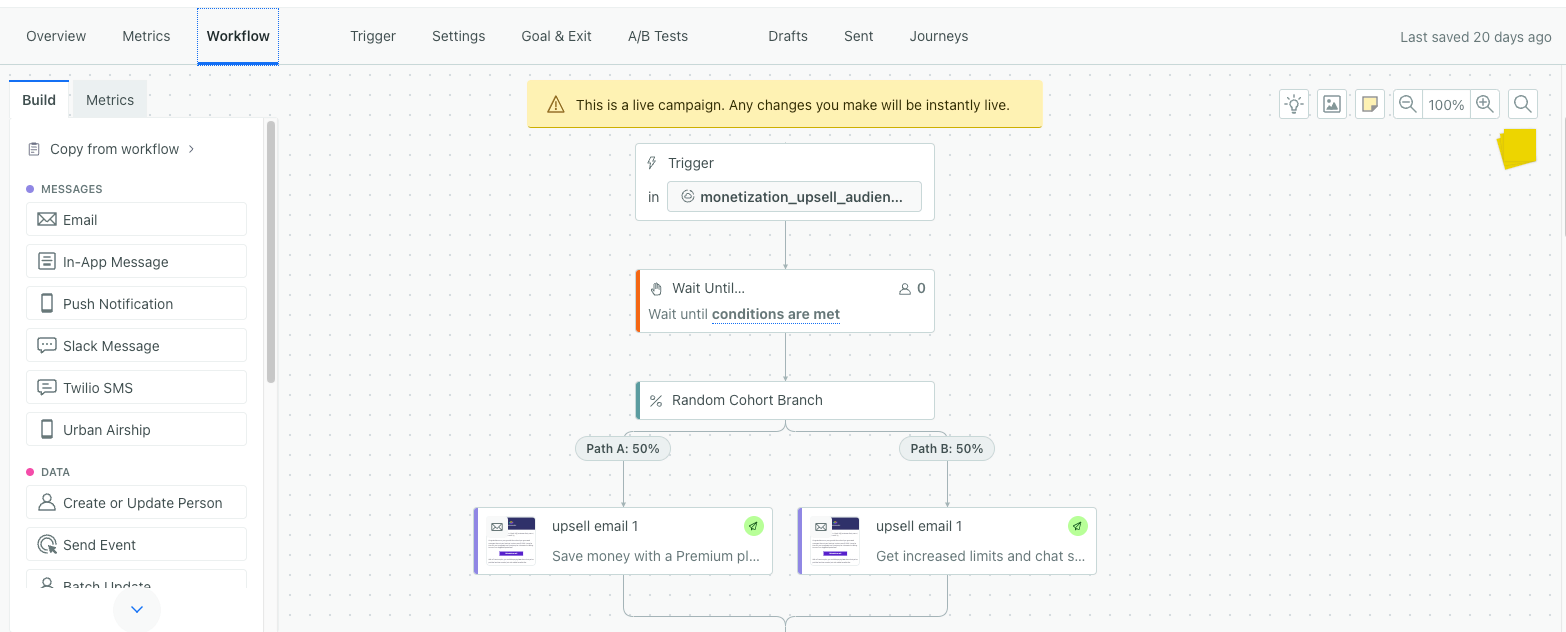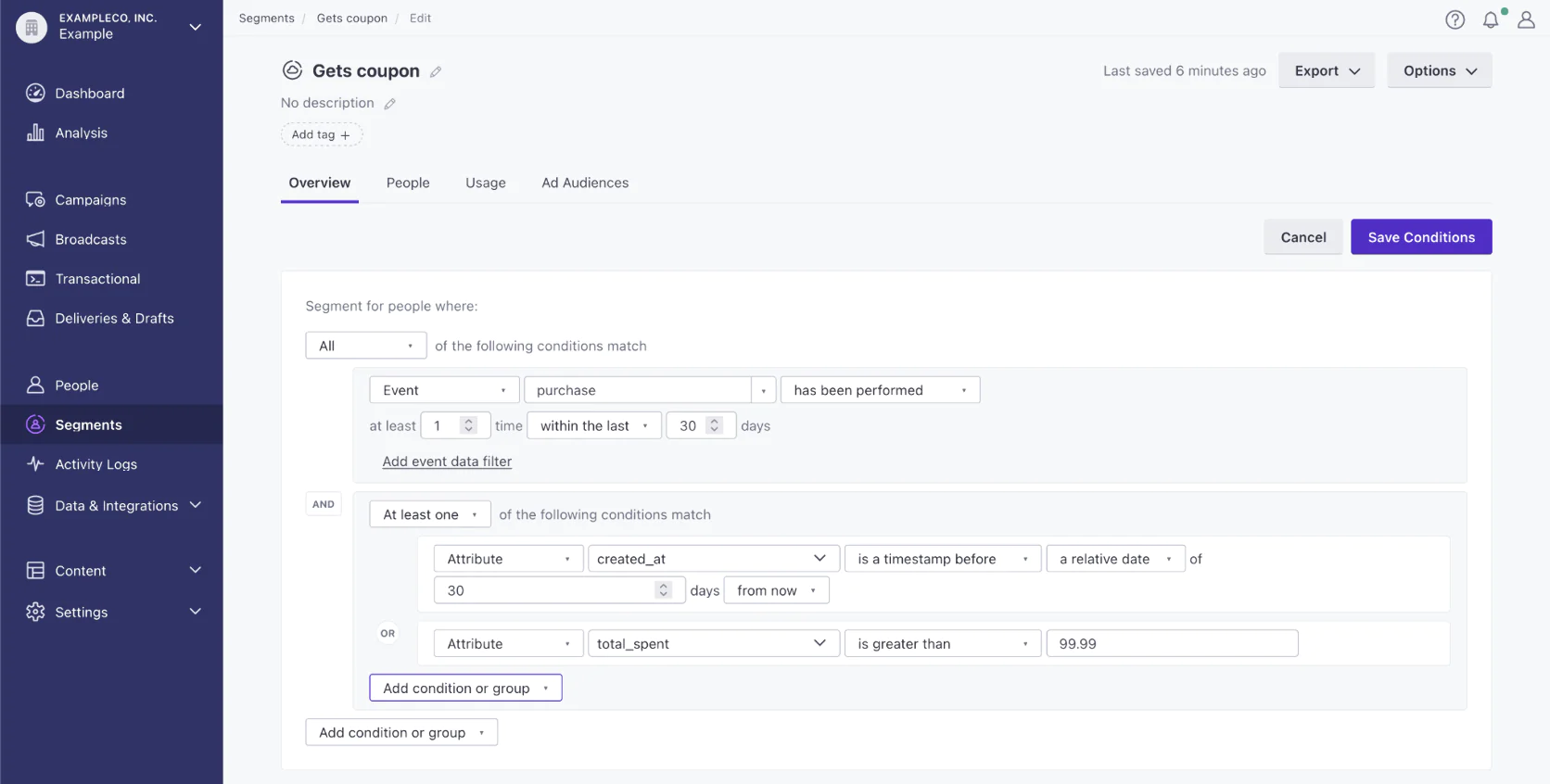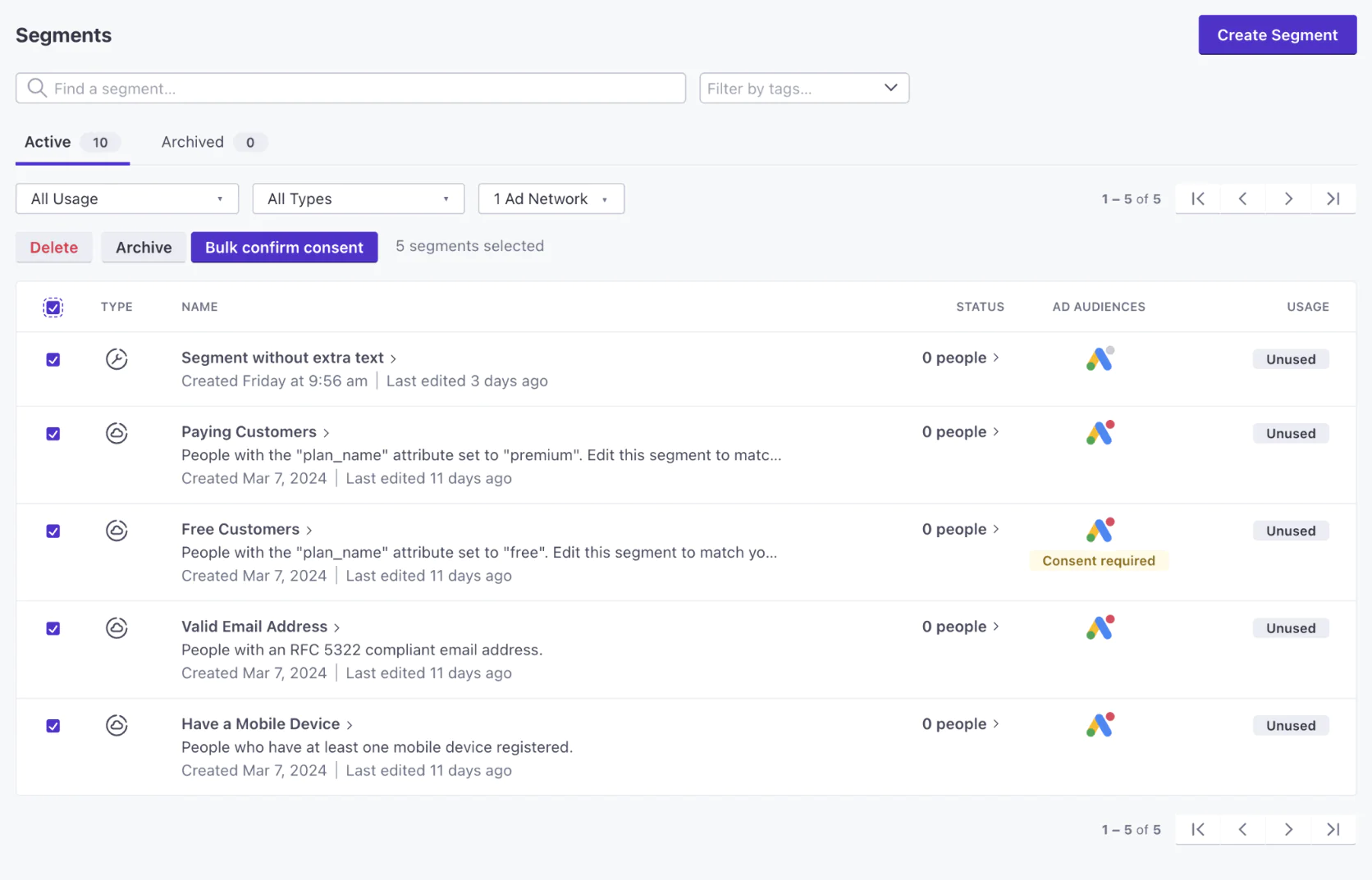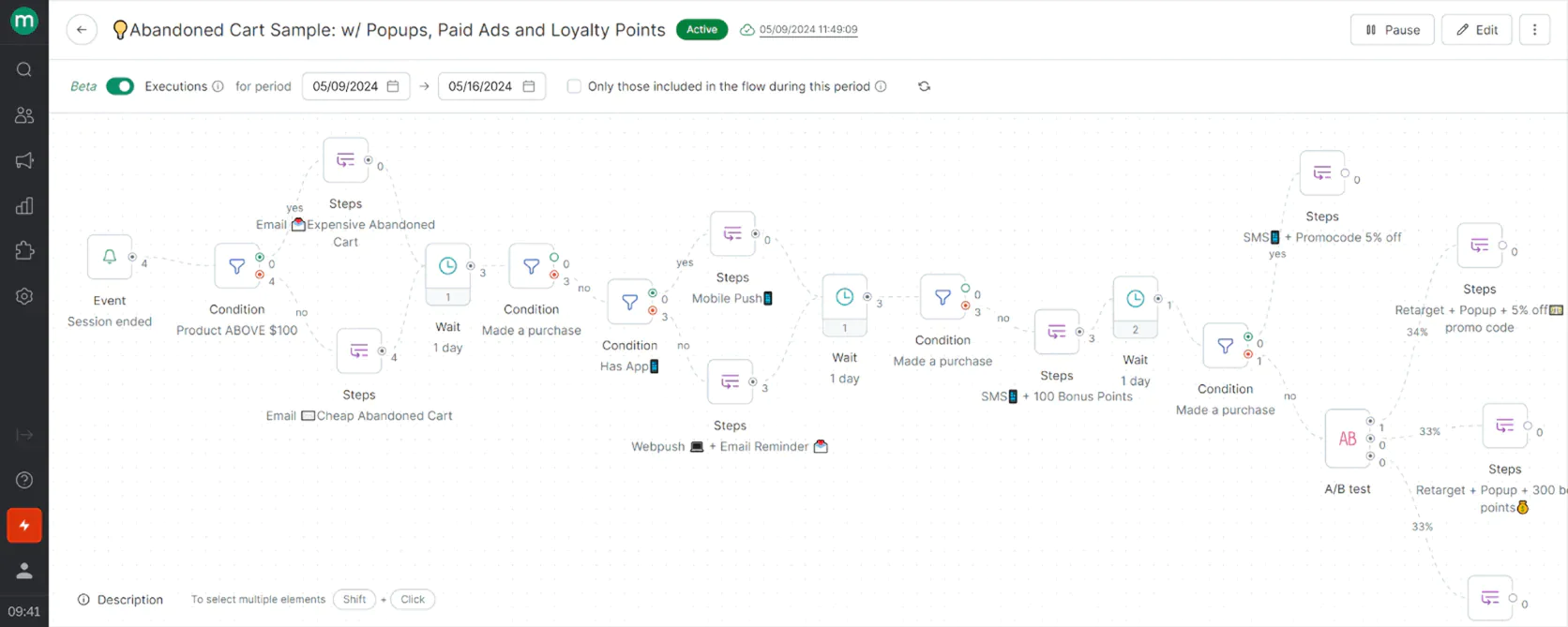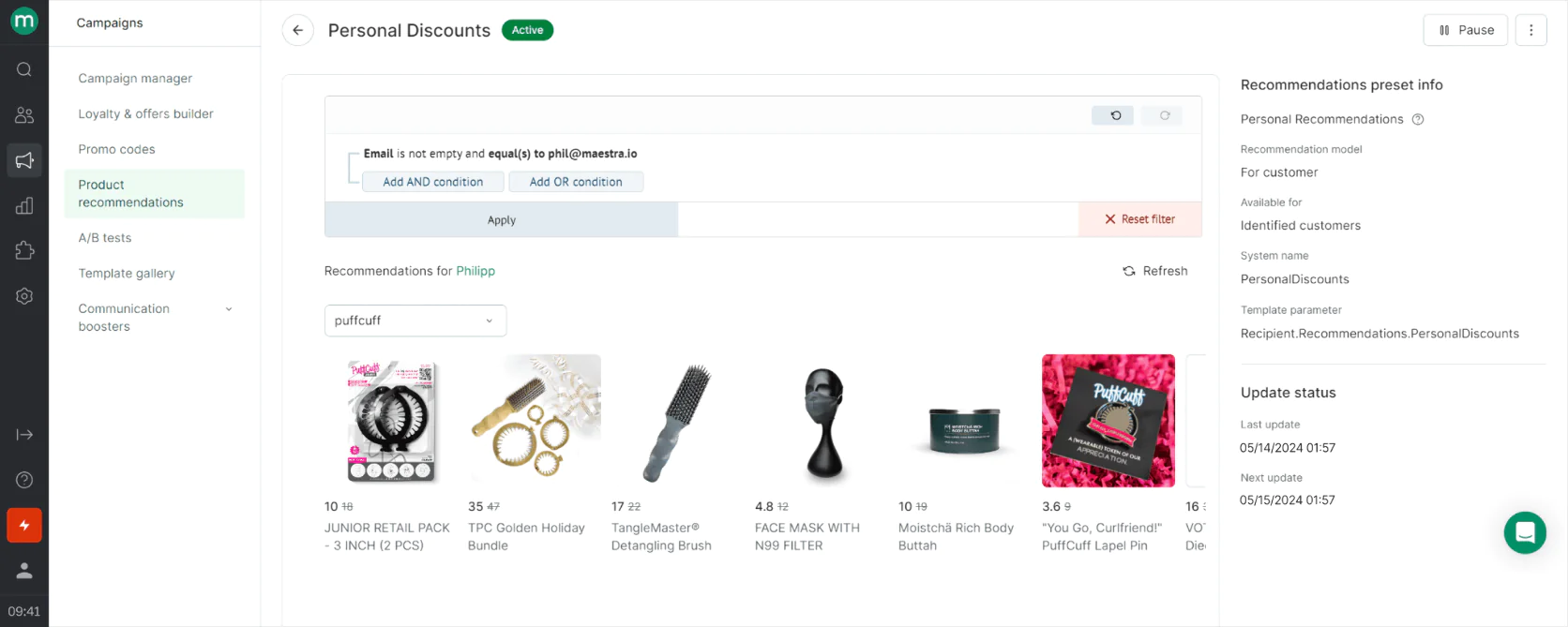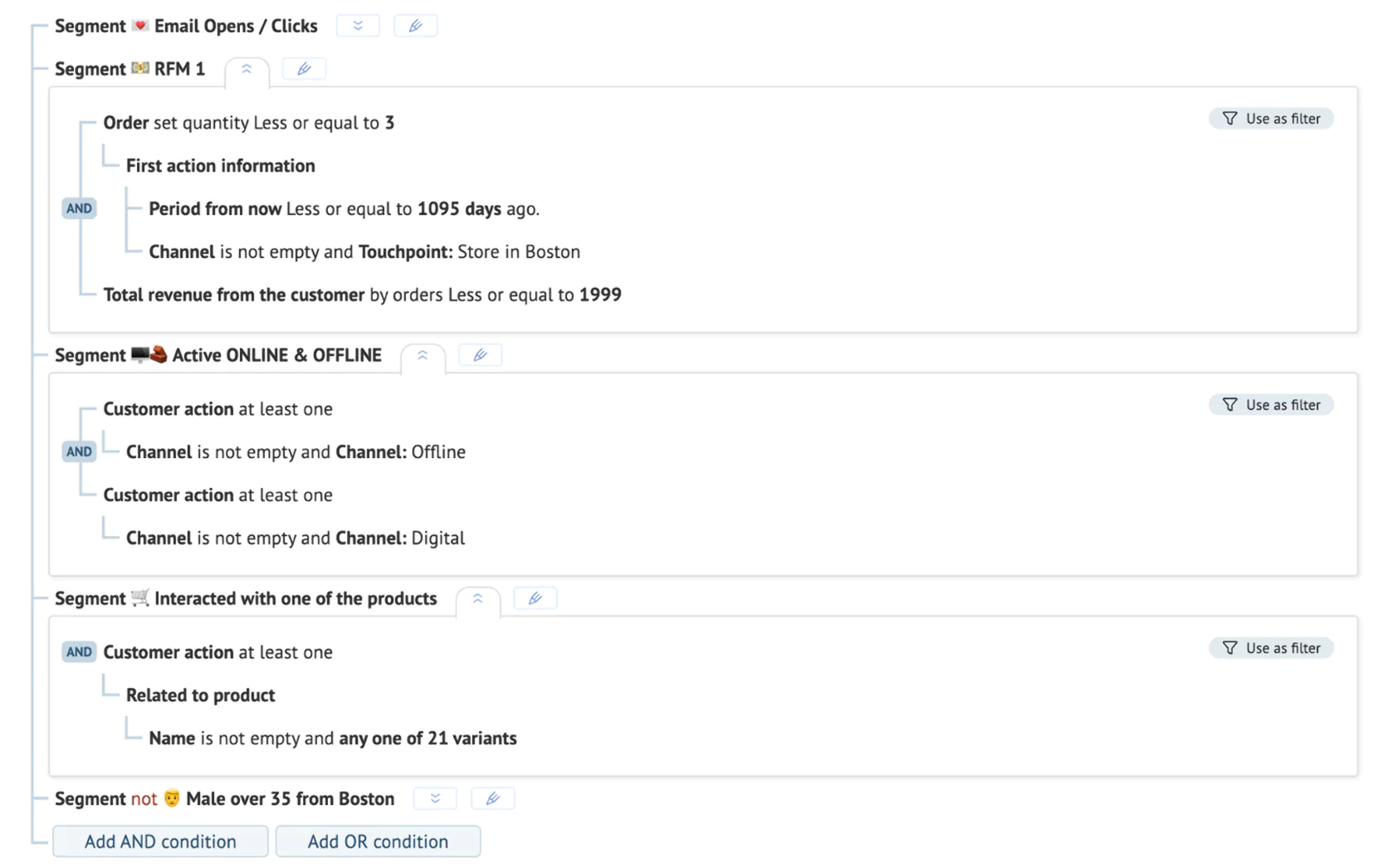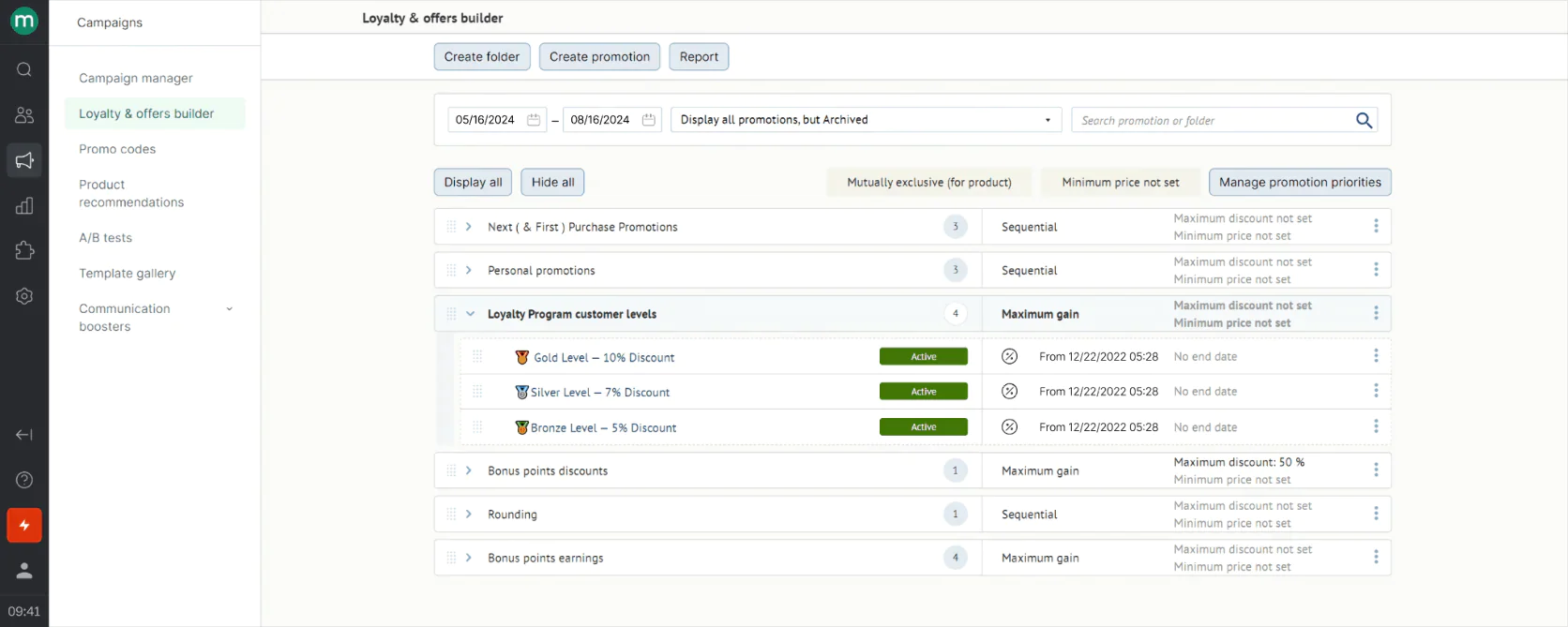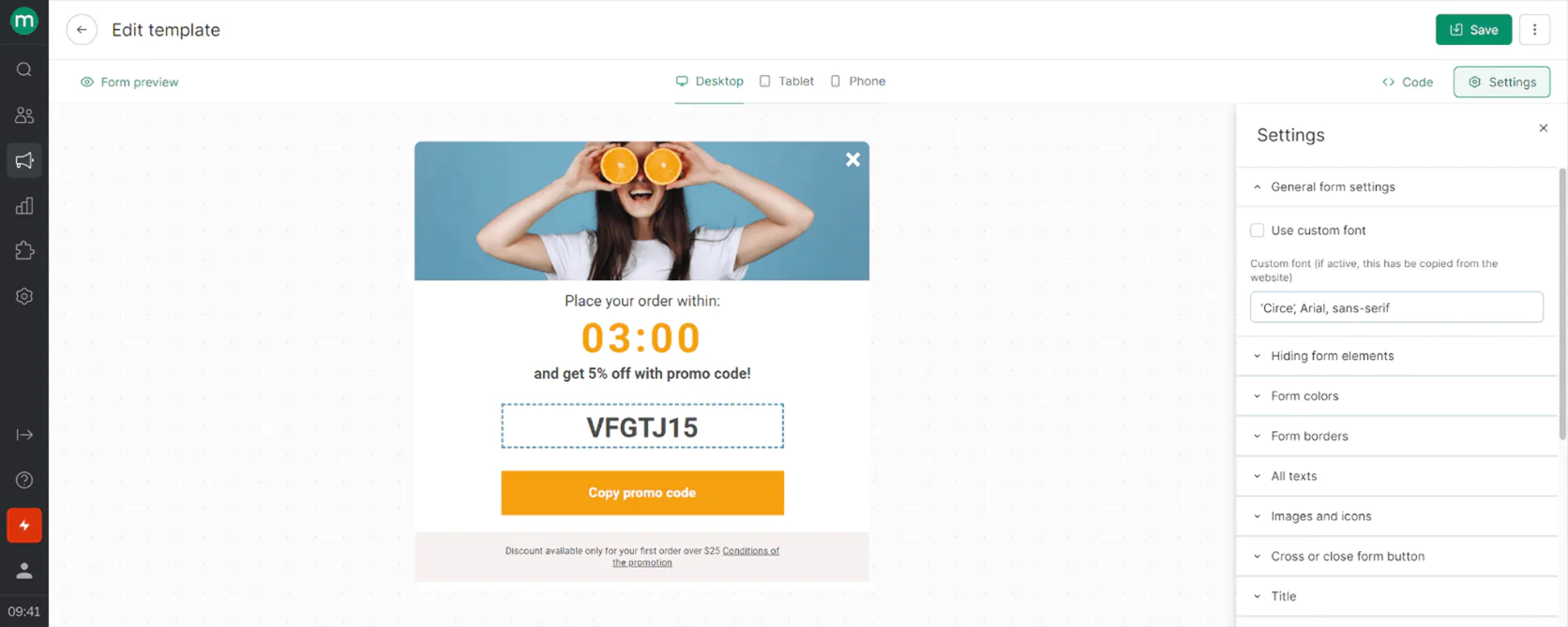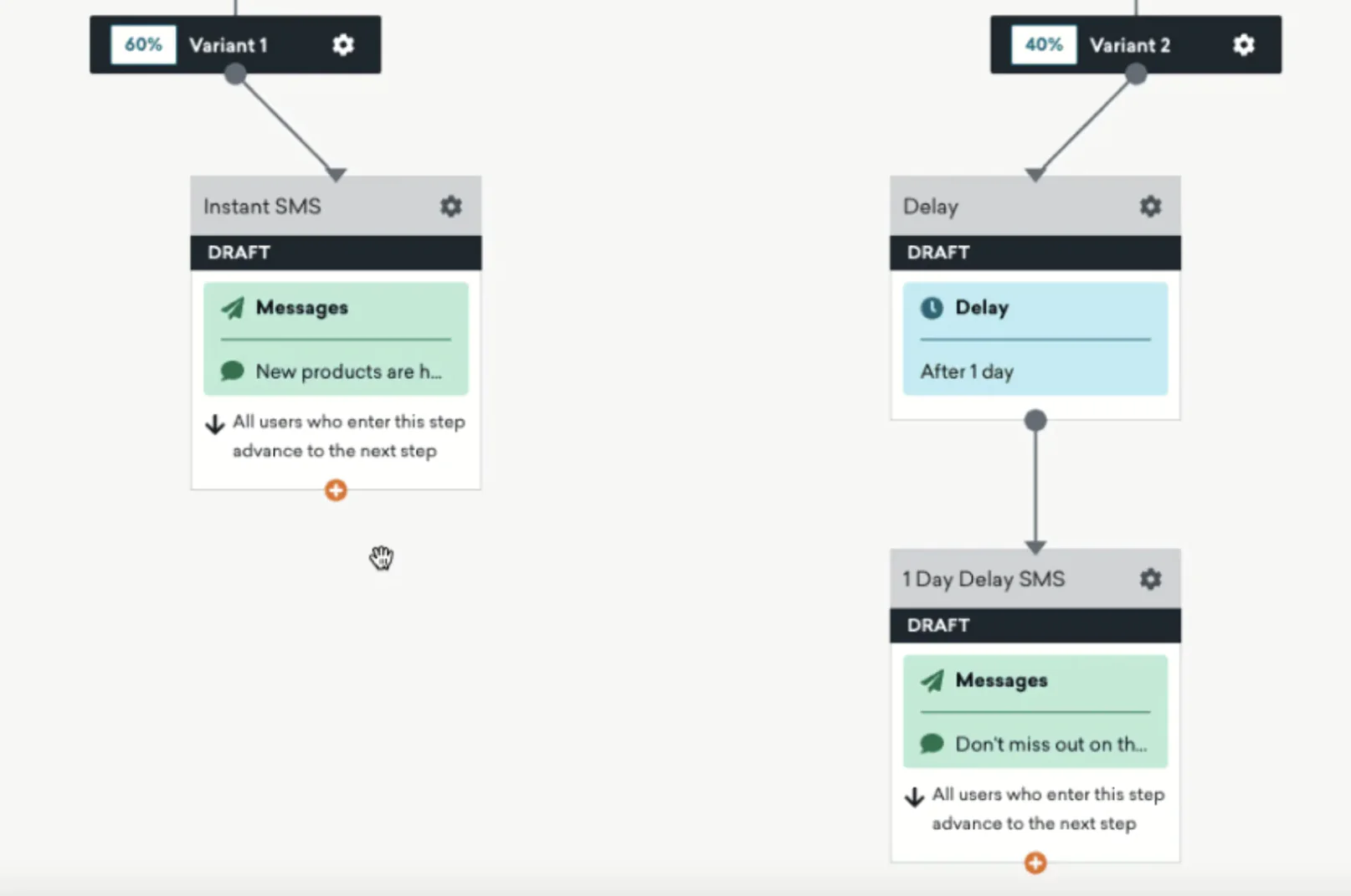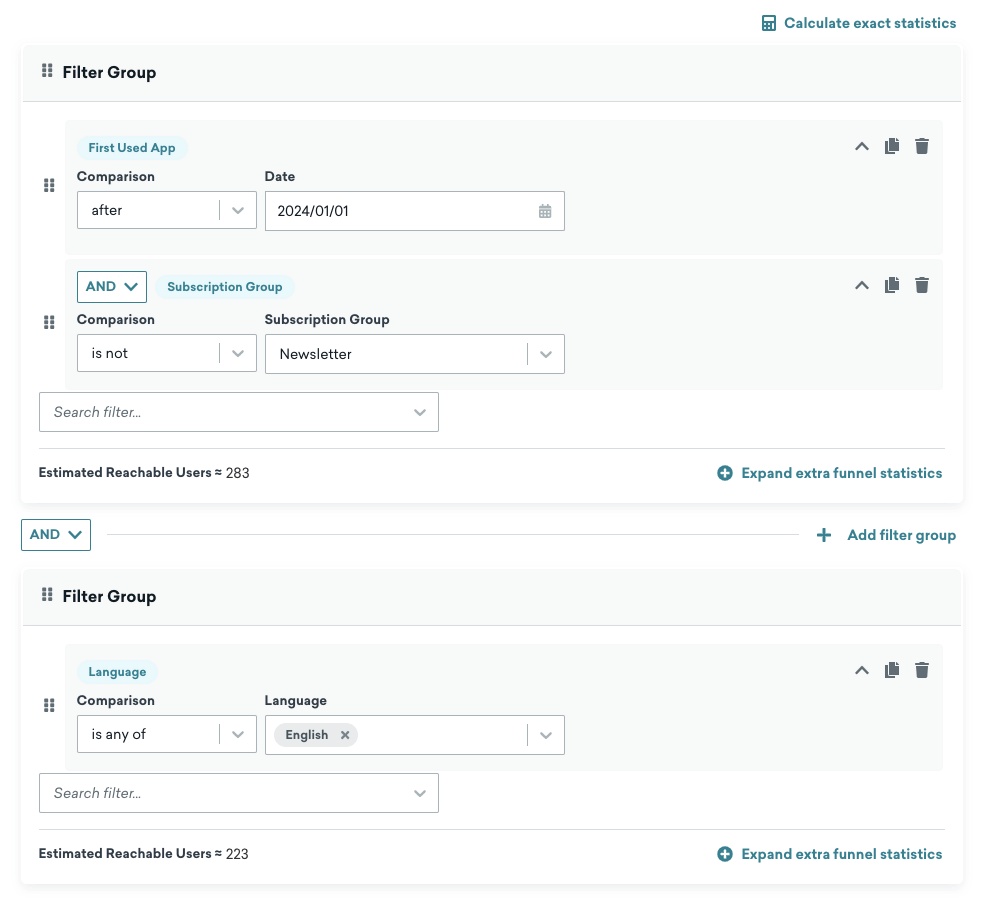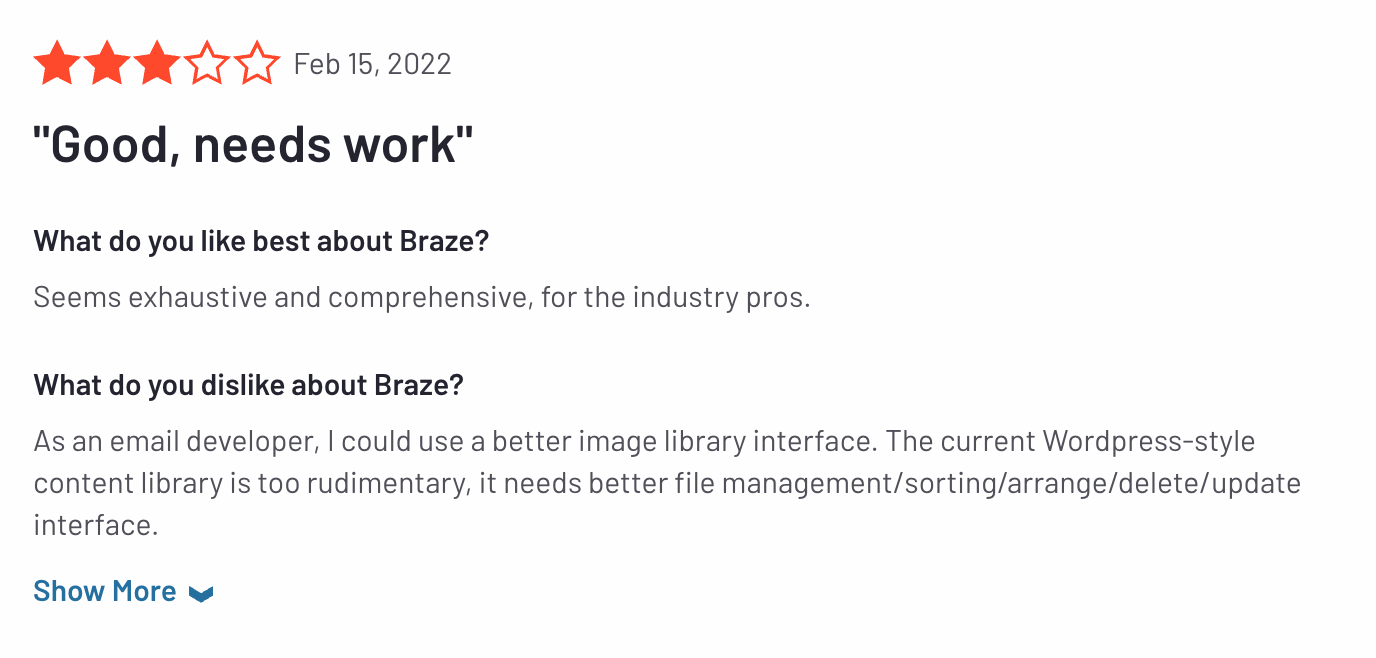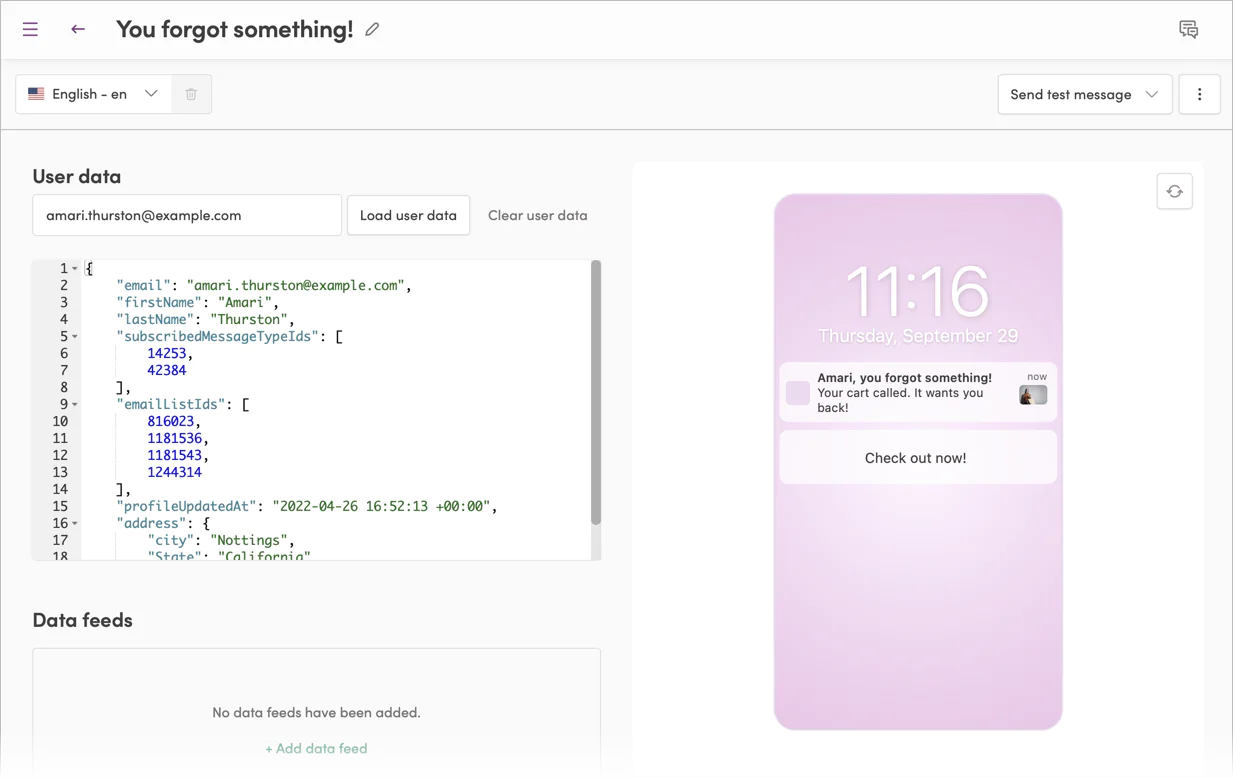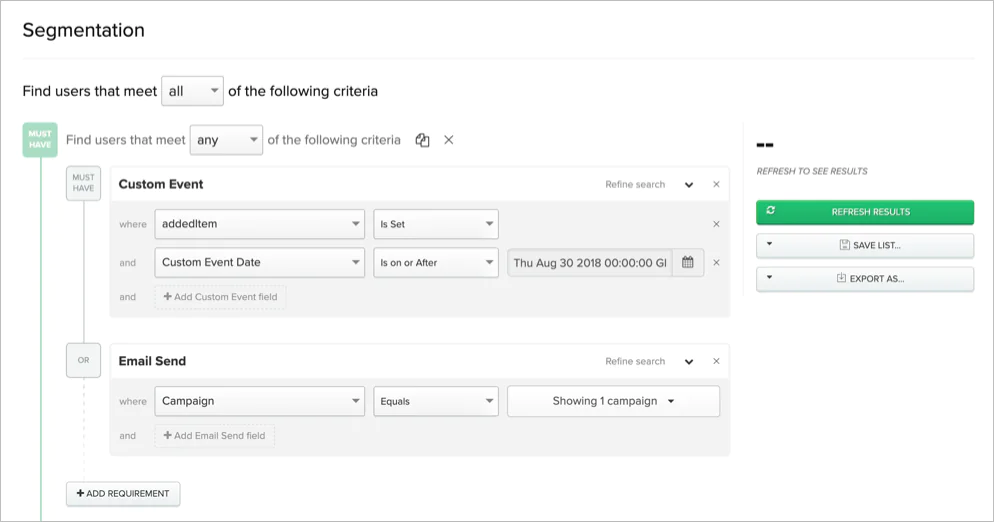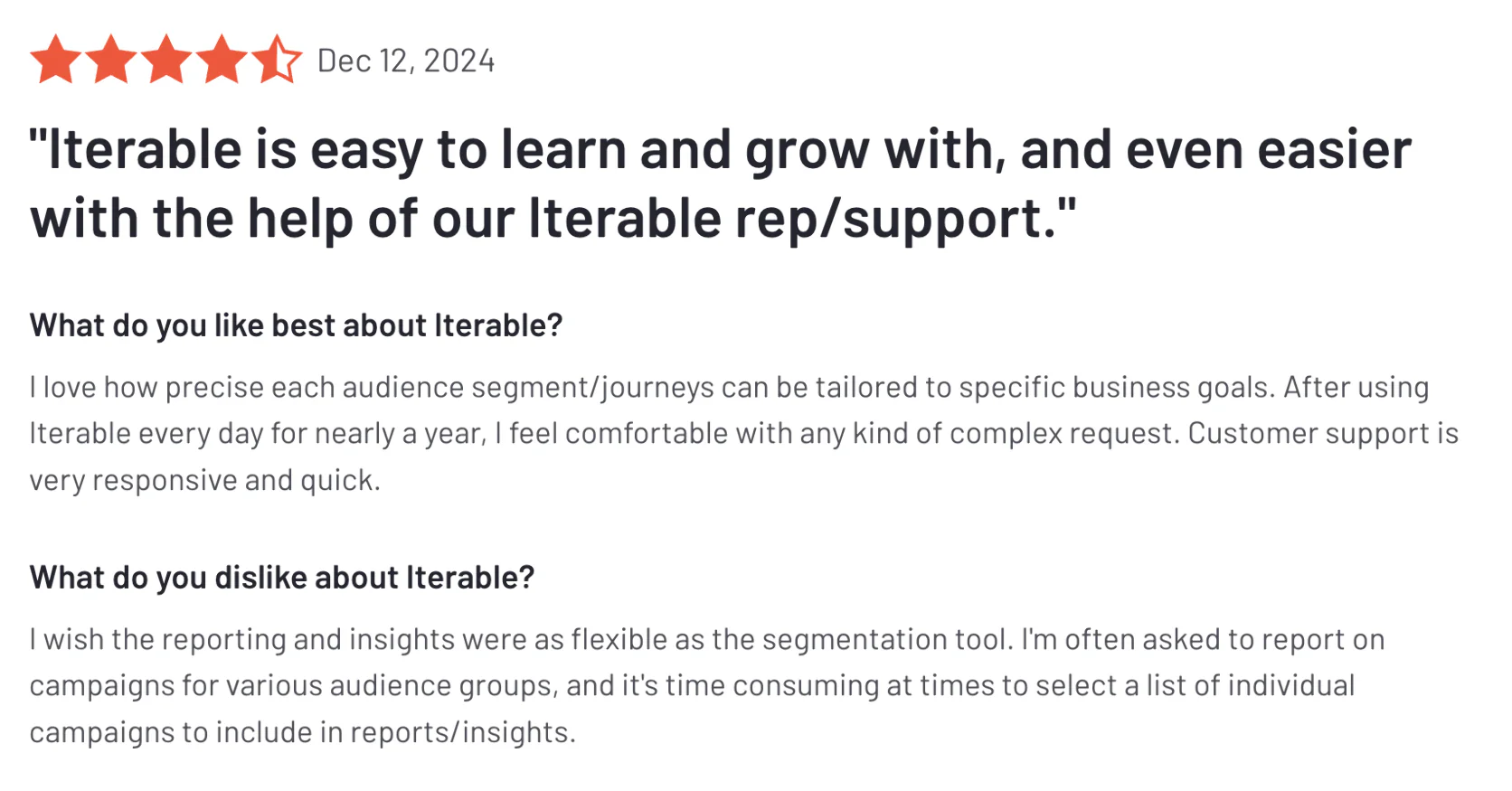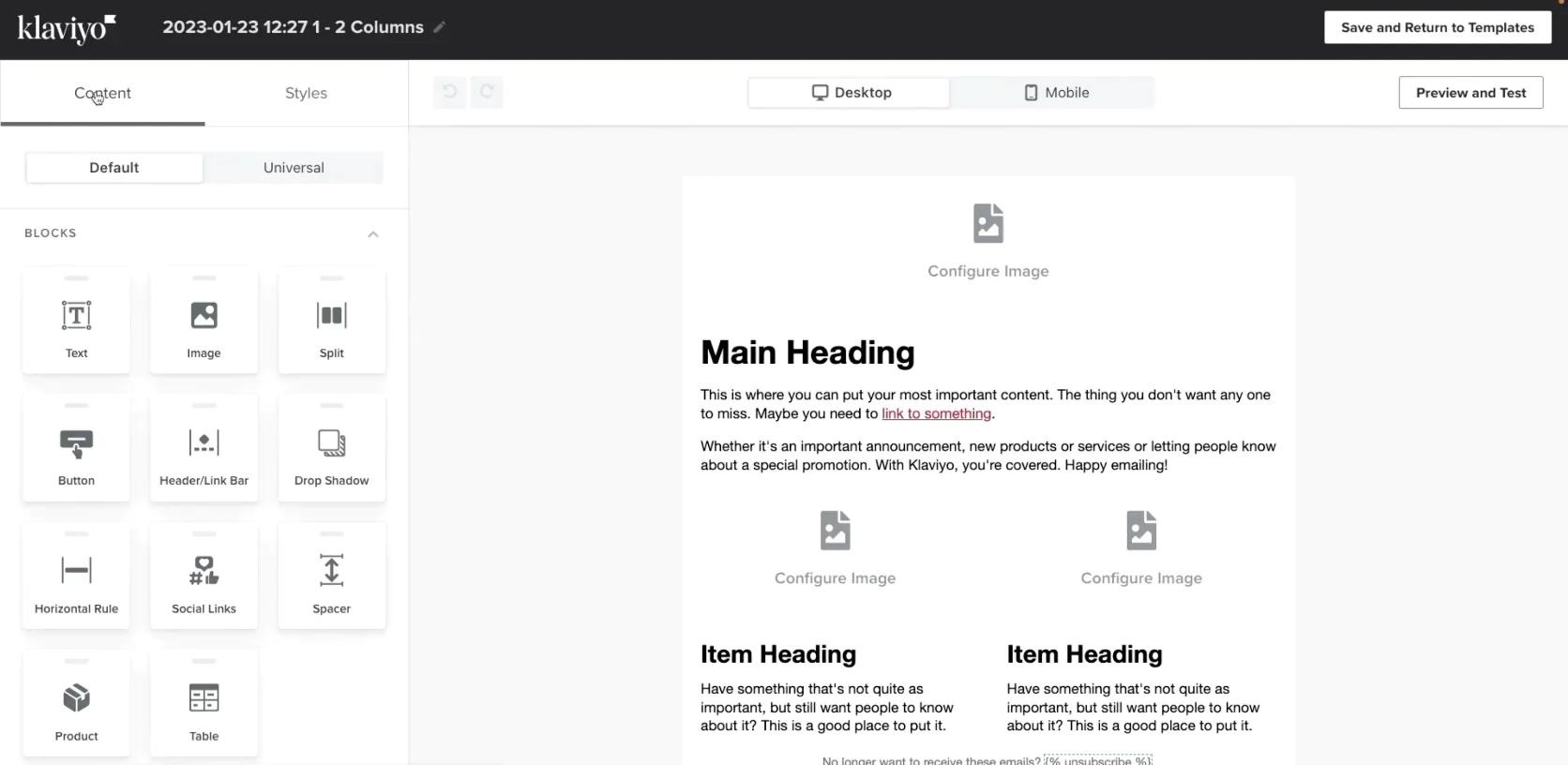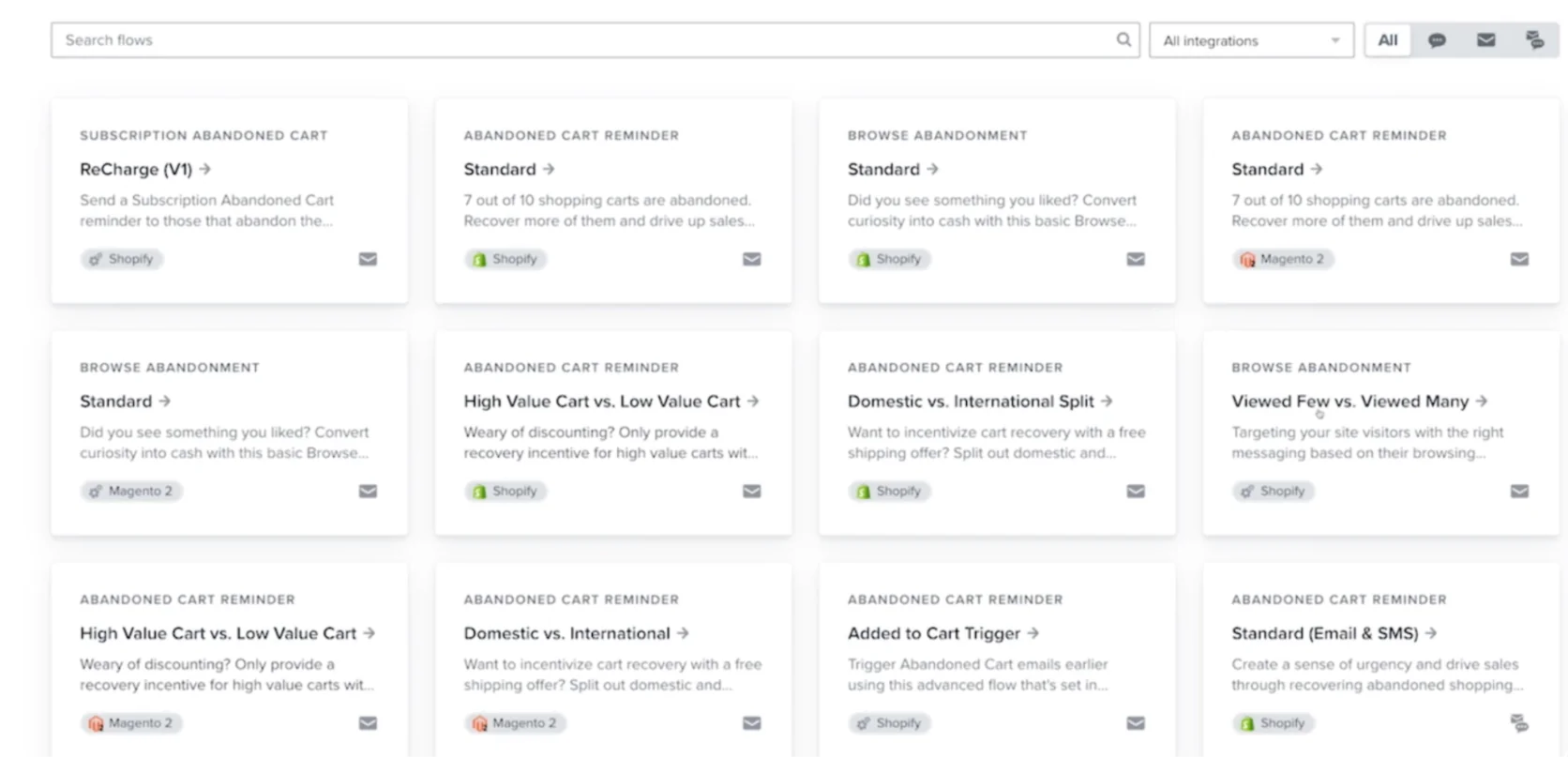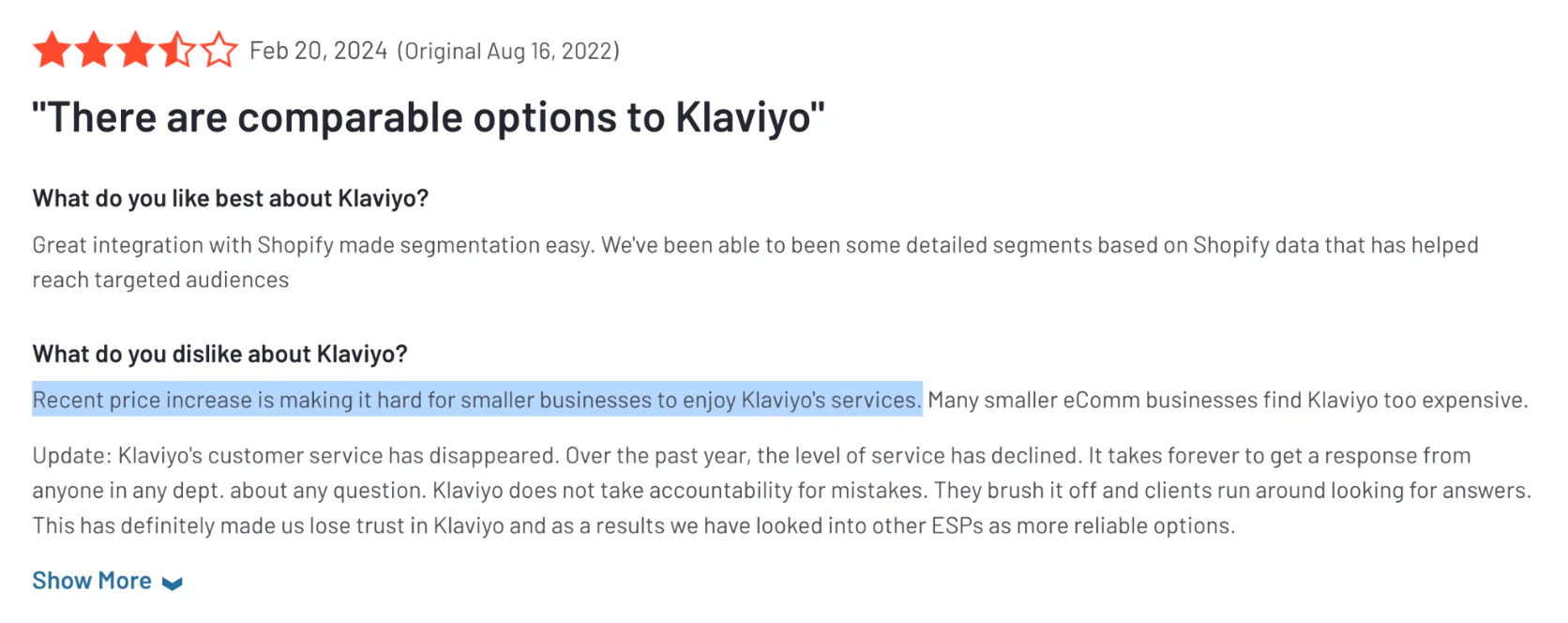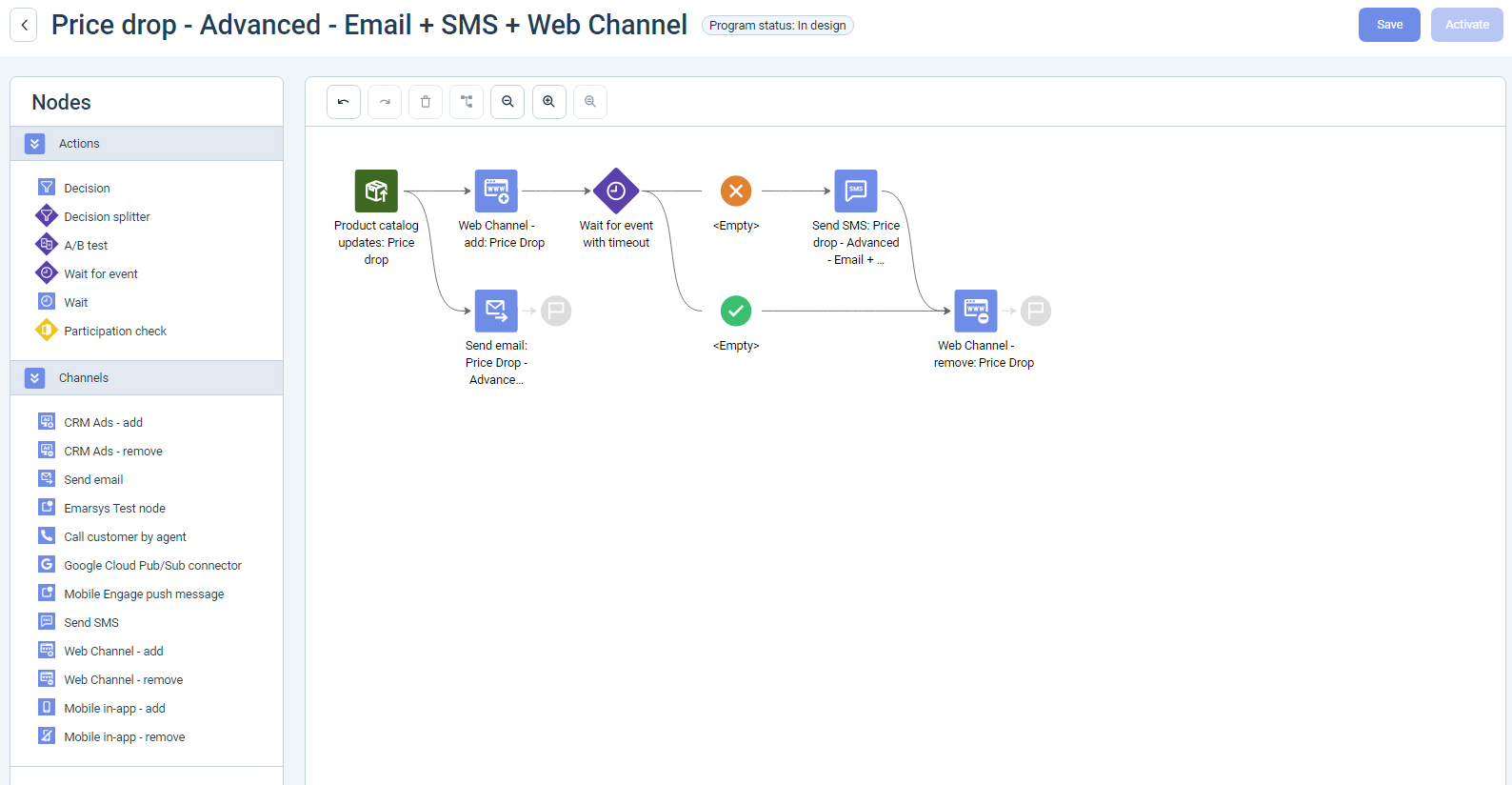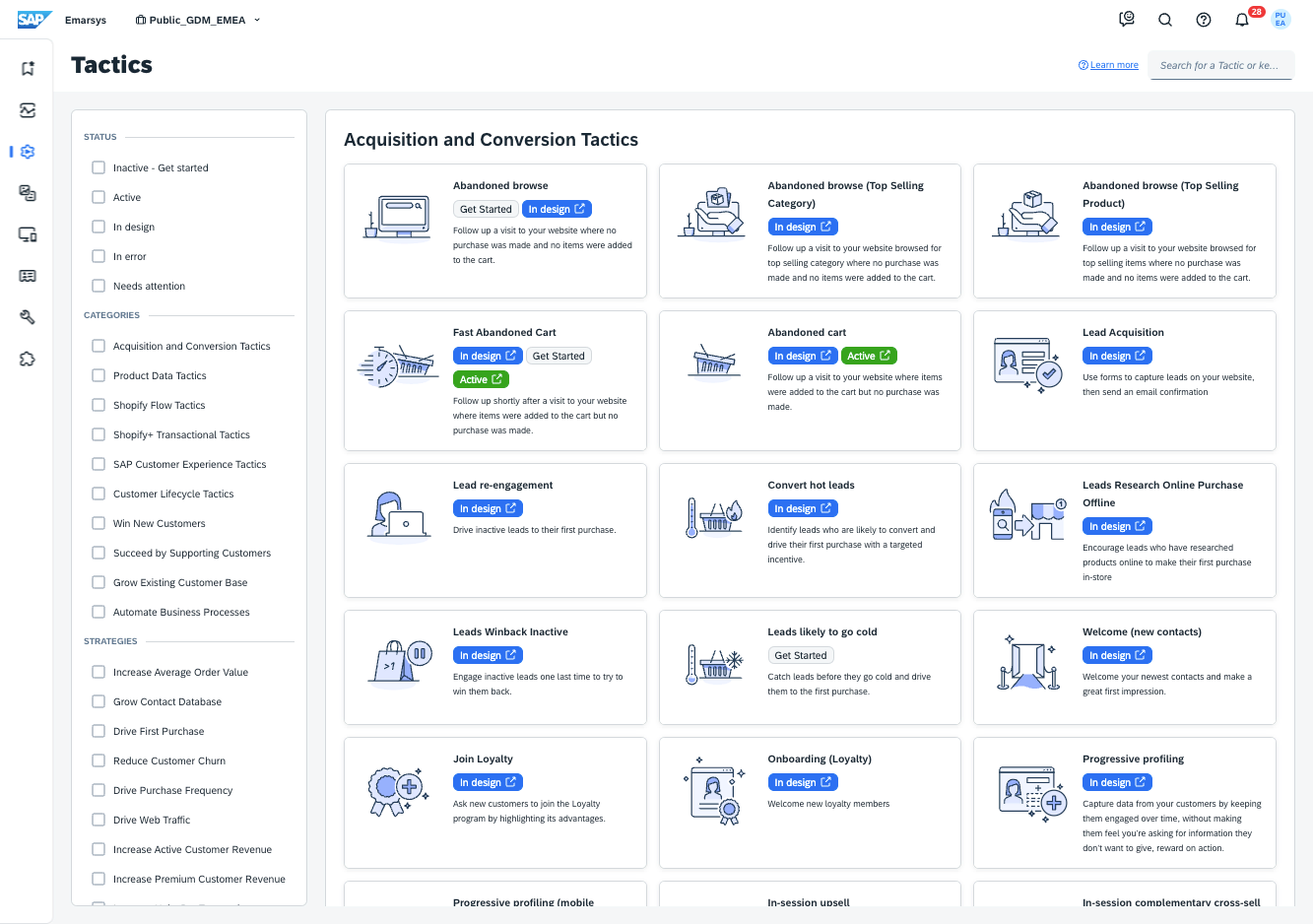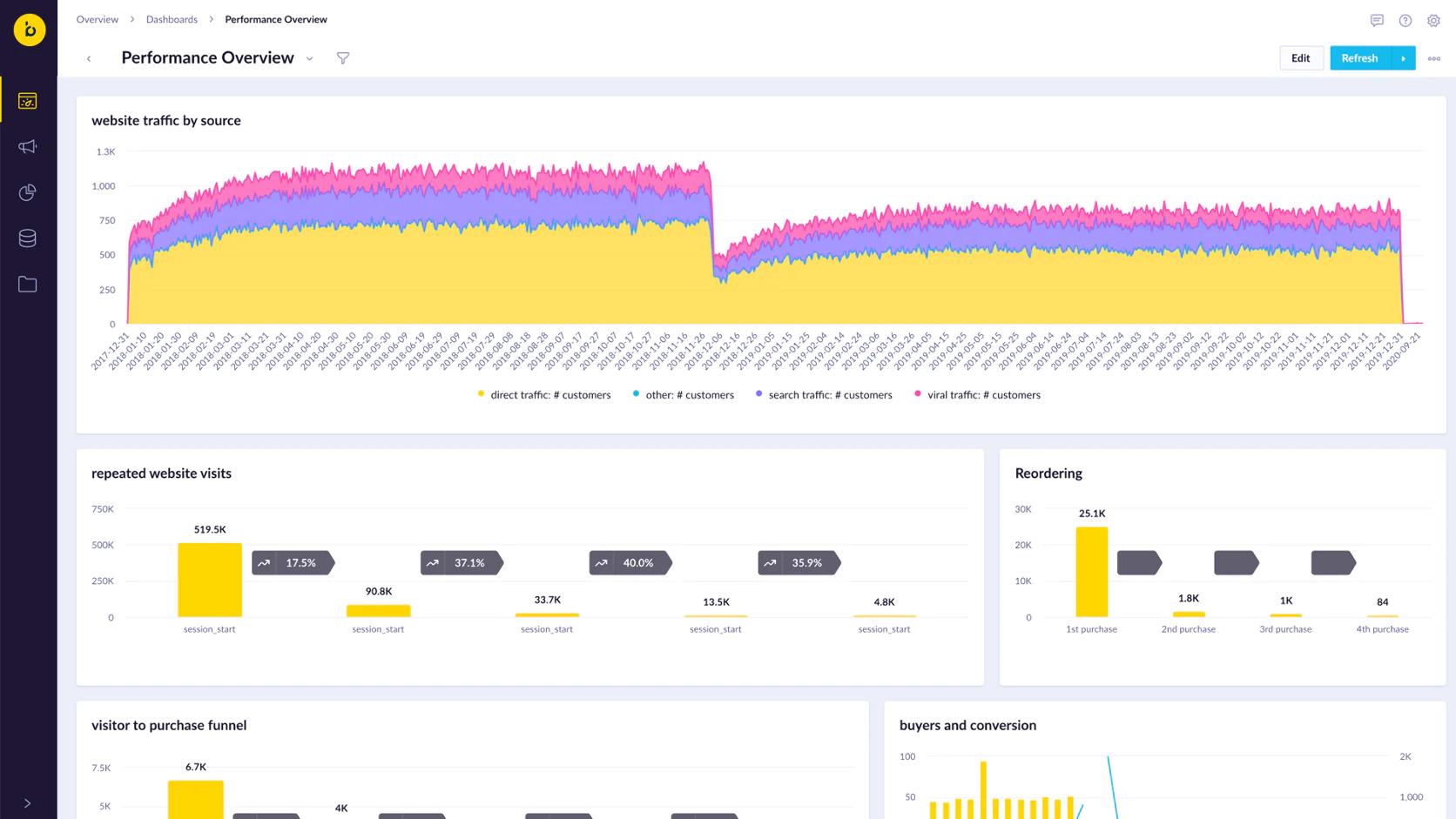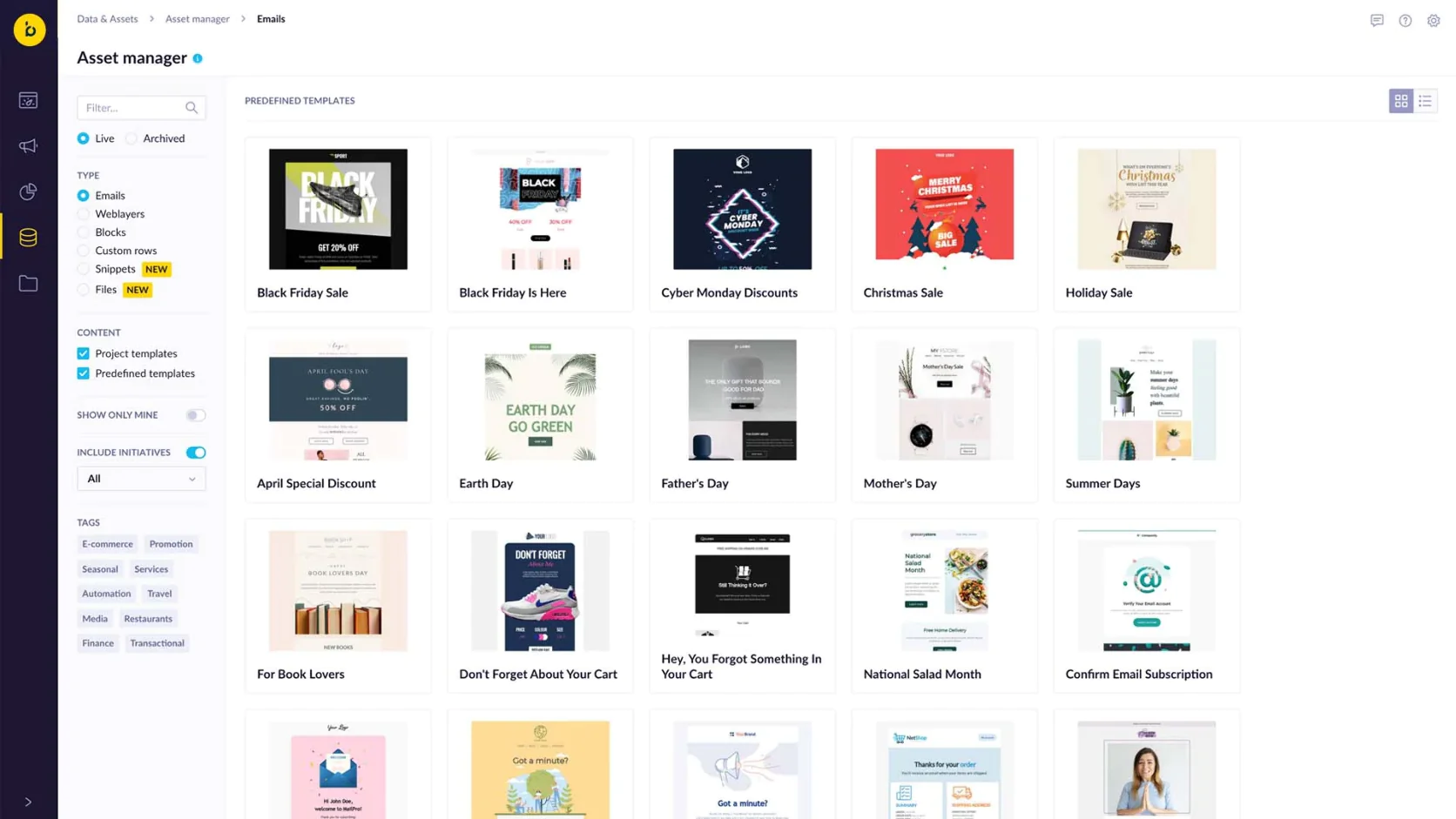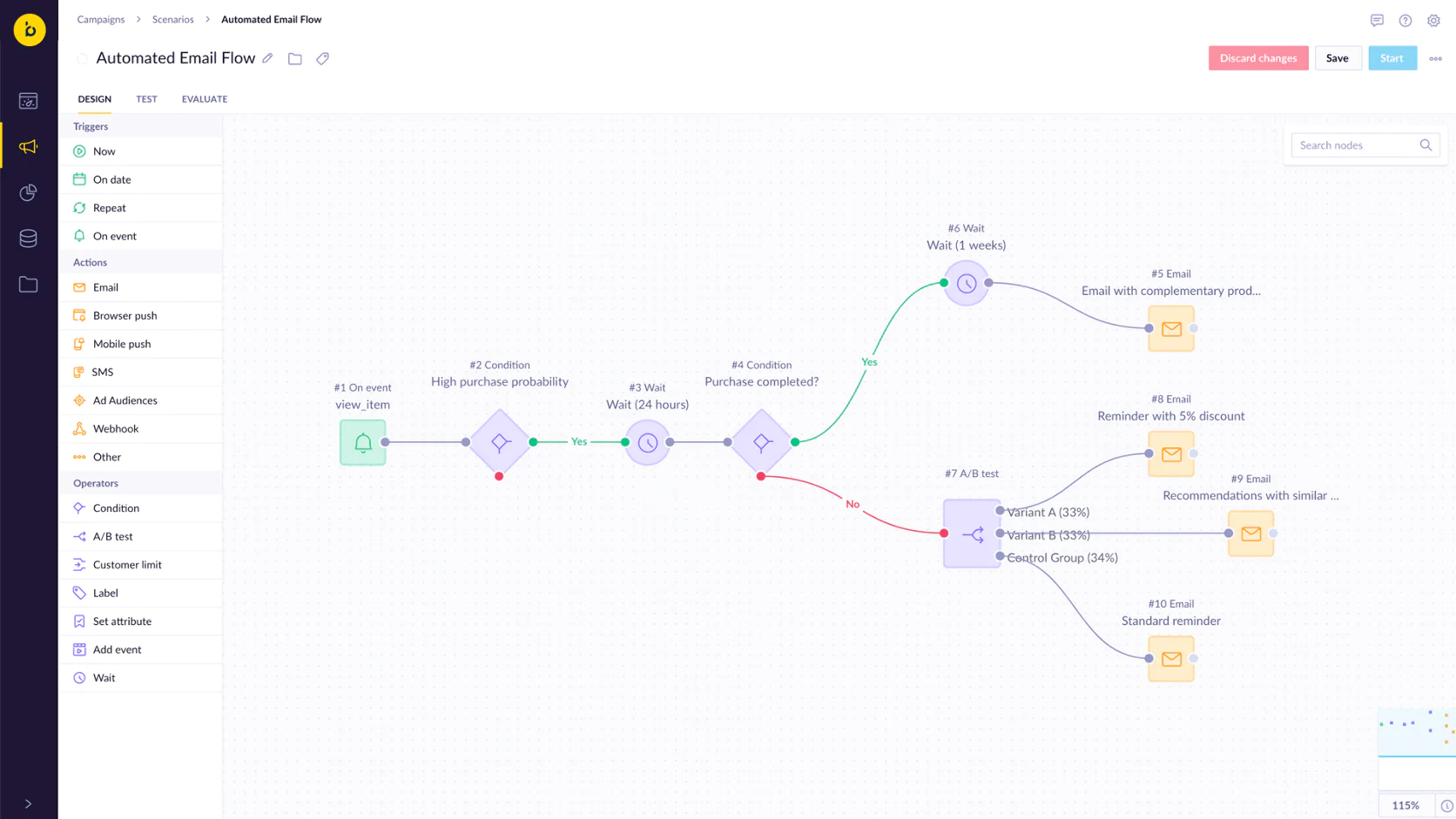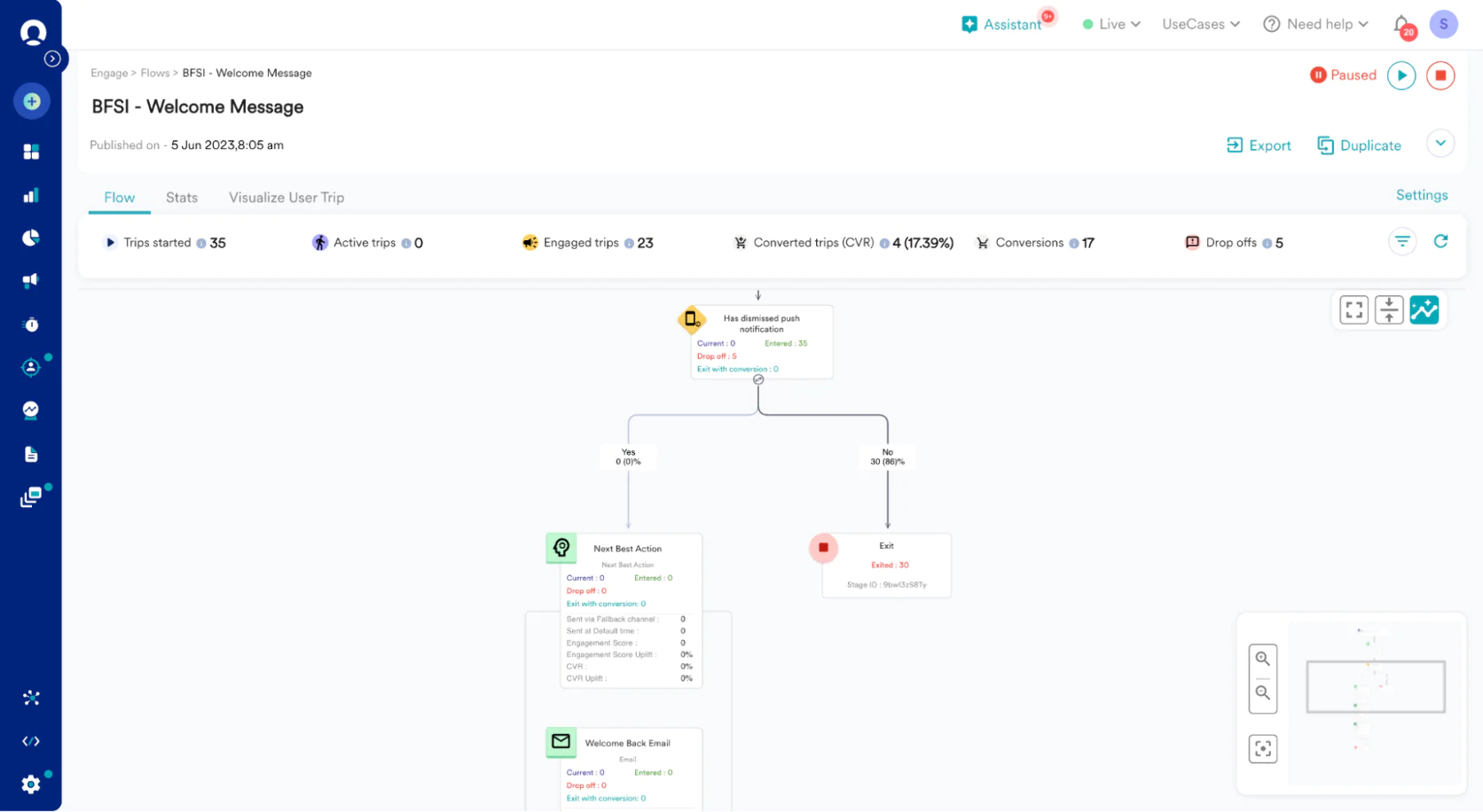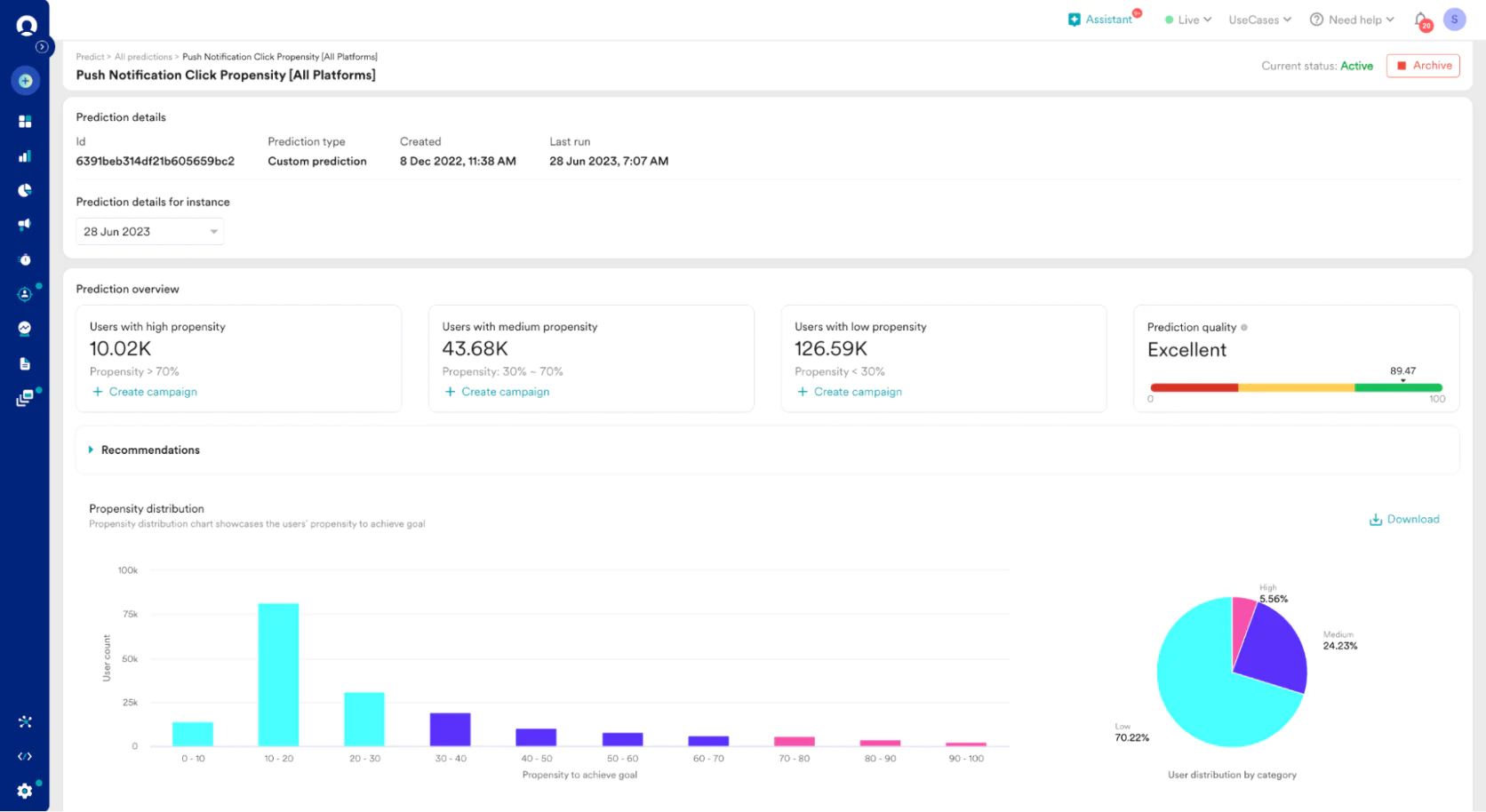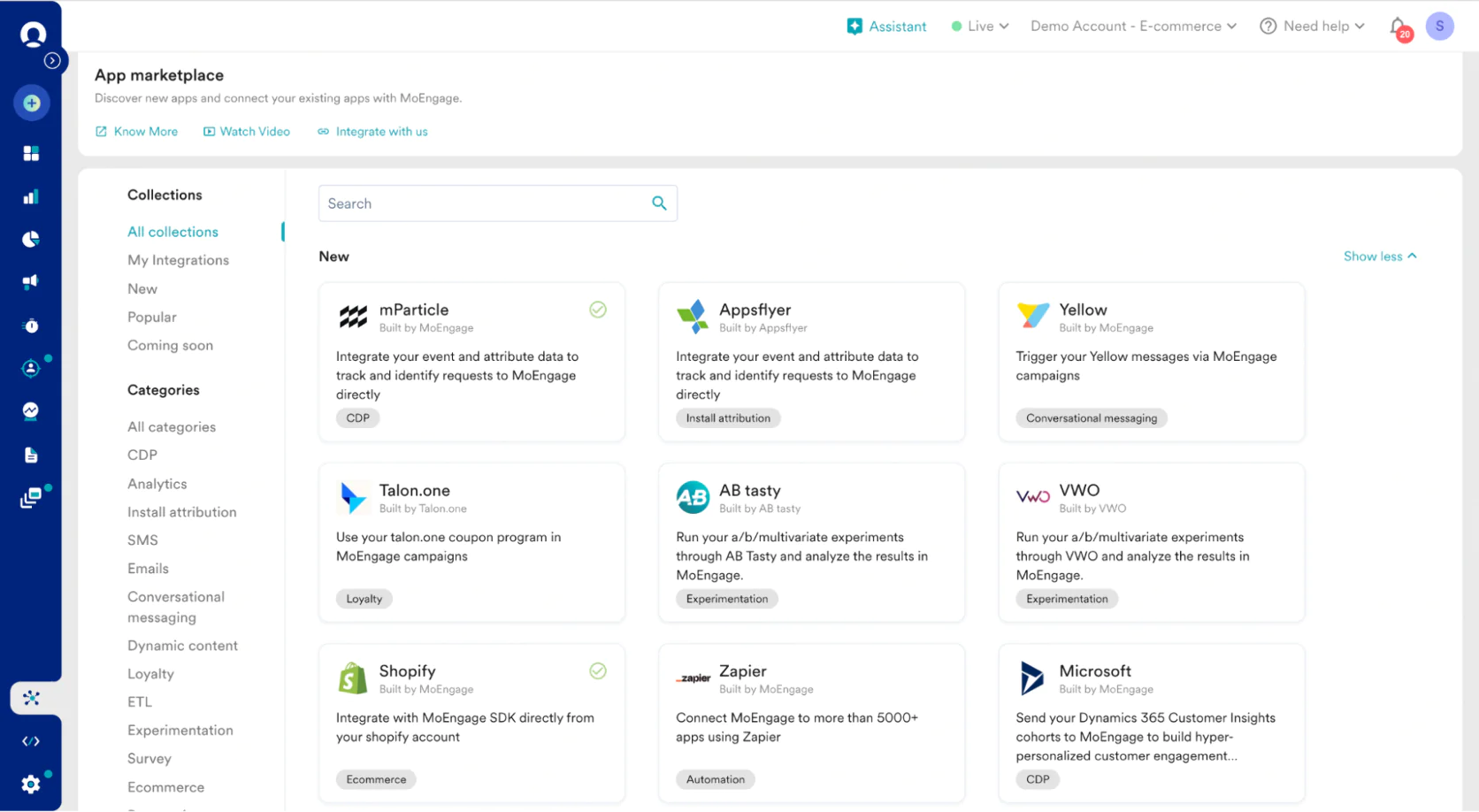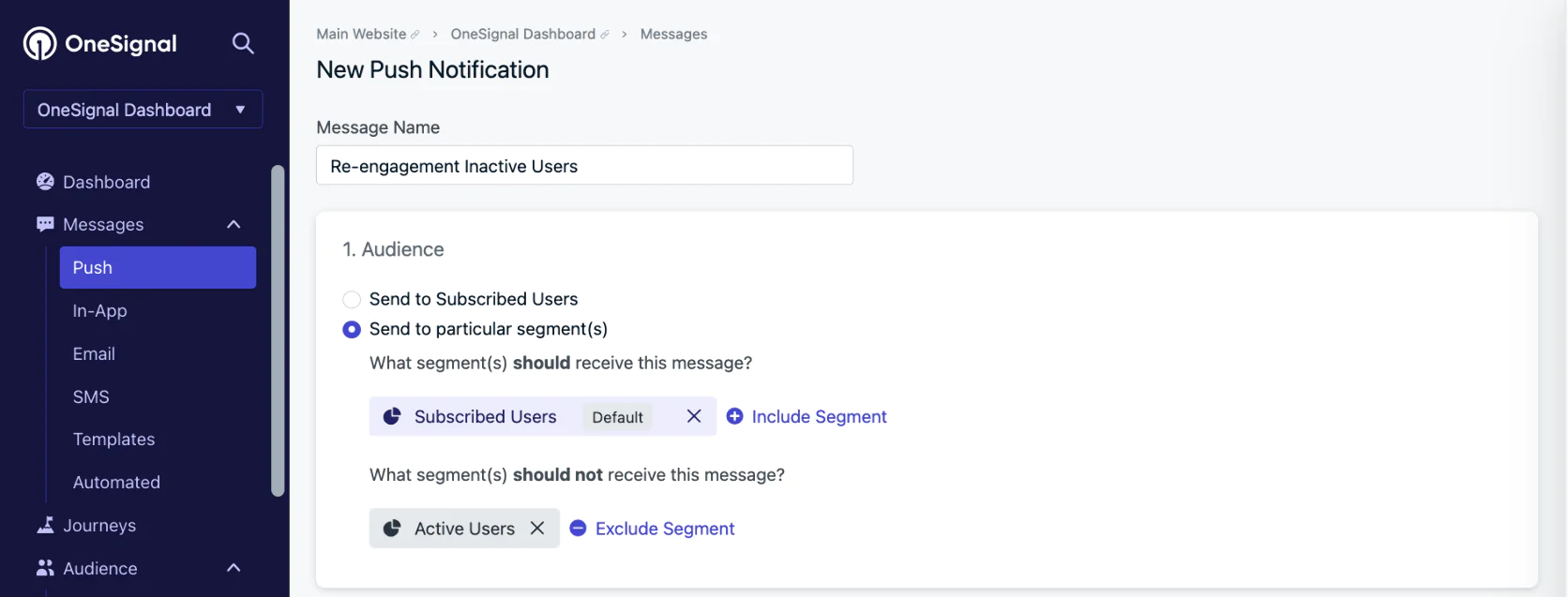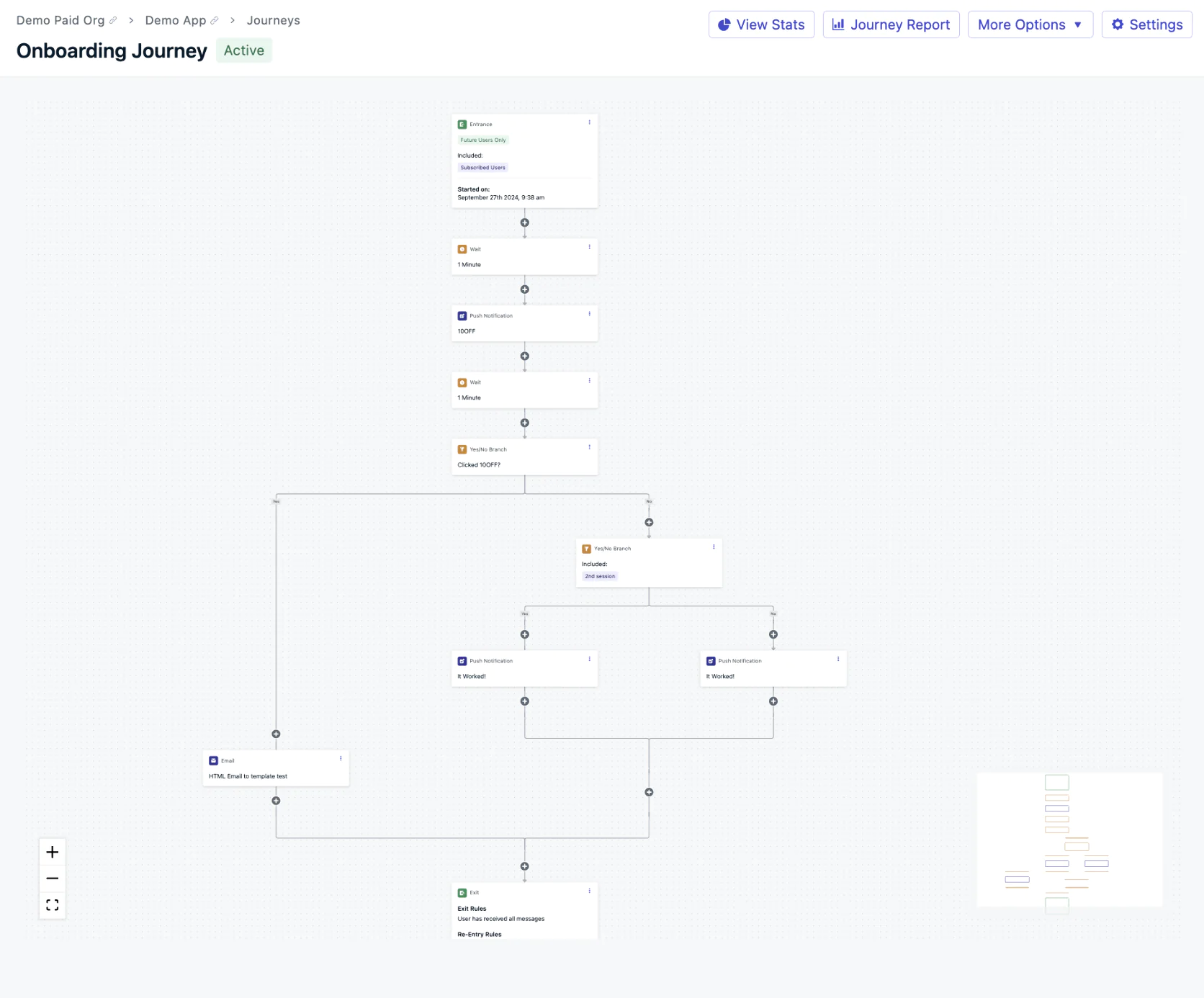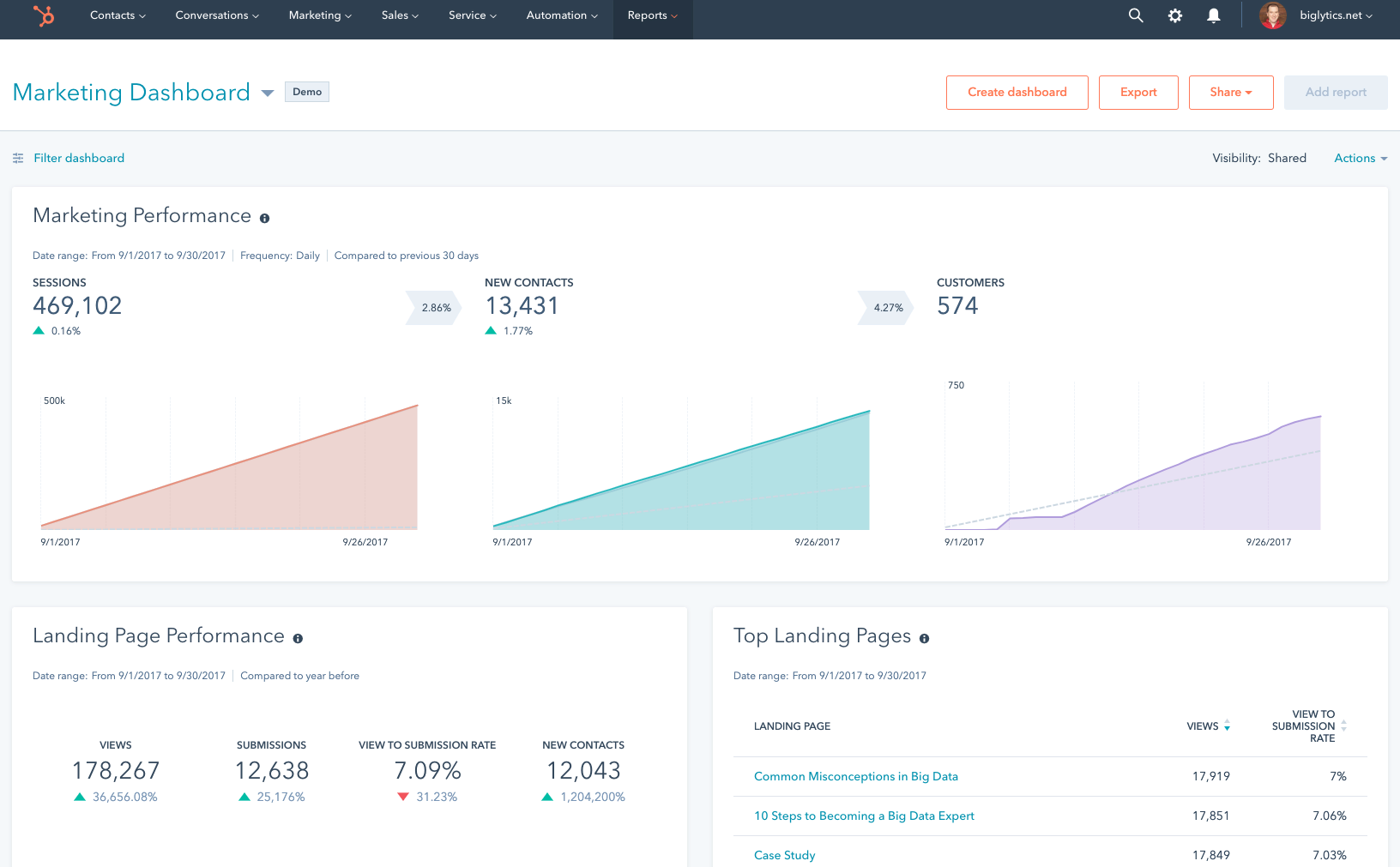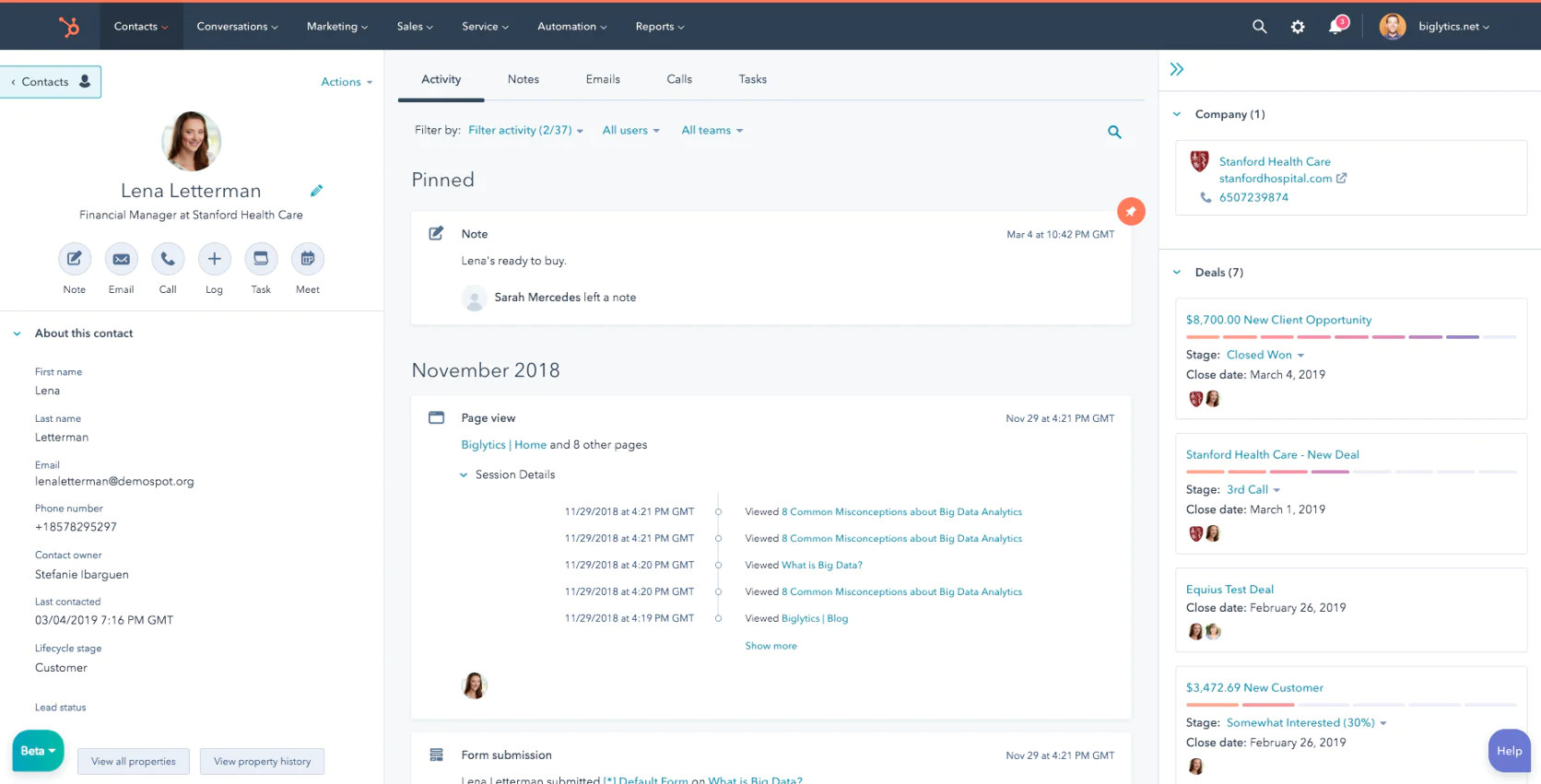10 Best Customer.io Alternatives for 2025: Smarter Customer Engagement
While Customer.io offers solid functionality for basic messaging workflows, ambitious marketing teams often hit limitations: disconnected customer data, missing channels, limited personalization capabilities, or simply the need for more strategic support as their programs mature.
This guide examines the top 10 Customer.io alternatives for 2025. We’ll explore each platform’s core strengths, ideal use cases, pricing considerations, and how they stack up against both Customer.io and each other. Whether you’re looking for deeper analytics, more sophisticated omnichannel capabilities, better e-commerce integration, or simply a more intuitive user experience, you’ll find clarity on which platform best aligns with your specific marketing goals and organizational needs.
Let's start by understanding what Customer.io does well—and where its limitations might be pushing you to explore alternatives.
Customer.io is a customer engagement platform (CEP) that helps businesses send targeted messages across multiple channels. Its claim to fame is flexibility and control for tech-savvy teams: you can weave together email, SMS, push notifications, in-app messages, and even webhooks in a single workflow.
Customer.io: flow builder
Customer.io offers a powerful segmentation engine without hard limits on attributes or triggers, giving marketers plenty of freedom to personalize campaigns.
Customer.io: user segmentation
An intuitive workflow builder makes it relatively easy to set up sophisticated automated campaigns triggered by events, time delays, or user behaviors. The platform also boasts a flexible data model (including a rudimentary built-in data warehouse sync) to manage customer data, plus APIs for those who want to get technical.
Customer.io’s ad audience syncing
In short, Customer.io has earned its reputation as an innovative, developer-friendly marketing automation tool for growing companies.
Customer.io: visual email composer
Pricing starts at about $100 per month for the base package, which includes unlimited event tracking and basic messaging functionality. For early-stage and mid-size teams, it’s a solid starting point.
However, as with any platform, there are trade-offs. Customer.io’s strength in flexibility can become a weakness for teams lacking engineering resources—its power often assumes you’ll plug in your own data and logic. Out-of-the-box solutions (like pre-built loyalty programs or product recommendation engines) are absent, meaning you’ll need additional tools or custom work to deliver those experiences. And while the platform scales technically, larger enterprises might find Customer.io’s support and strategic guidance limited compared to full-service platforms.
Why (or When) to Consider Alternatives
Customer.io is a decent springboard for businesses dipping their toes into automated lifecycle marketing. Its straightforward workflows work fine for basic needs. But as your company grows and your marketing gets more sophisticated, Customer.io’s limitations start to show. Scaling your customer engagement often means looking for a platform that can grow with you, not hold you back.
For brands now focused on creating truly connected, personalized customer journeys, flexibility and scalability aren’t optional—they’re essential. You might find yourself needing features Customer.io doesn’t offer natively, like built-in loyalty rewards, advanced on-site personalization, or AI-driven product recommendations.
You may want more hands-on support or a solution tailored to e-commerce and retail use cases, rather than a one-size-fits-all tool.
Below, we’ve rounded up the top alternatives that mid-market and enterprise marketers are turning to in 2025.
The Alternatives at a Glance
With that in mind, let’s take a look at some of the popular Customer.io alternatives side by side:
Maestra
Full-funnel marketing for ambitious e-commerce brands
• Real-time CDP for behavior-driven segmentation
• Hyper-personalized omnichannel flows
• Built-in loyalty program and promotions engine, ads optimization
• Real-time site personalization
• Dedicated Customer Success Manager
From $2,990/month
Braze
Mobile-first engagement at enterprise scale
• Push notifications, in-app messaging, SMS, email in one platform
• Advanced segmentation with geo-targeting (shape-based filters)
• “Canvas” visual campaign builder for multi-step flows
• Robust analytics & personalization for mobile apps
Custom pricing (usage-based; enterprise-level)
Iterable
Cross-channel growth marketing for large teams
• Email, push, SMS, and in-app messaging in one hub
• AI-powered optimization and experimentation tools
• New in-app embedded content feature for dynamic app messages
• Flexible data integrations and rich segmentation
Custom pricing (similar to Braze; on the higher end)
Klaviyo
E-commerce email & SMS automation (Shopify standout)
• Unified customer profiles with purchase & browsing data
• Pre-built flows for cart recovery, win-back, etc.
• Strong Shopify, BigCommerce, and Magento integrations
• Predictive analytics for CLV and product recommendations
Free up to 250 contacts; Paid plans from ~$45/month and up (usage-based)
SAP Emarsys
Enterprise omnichannel personalization for retail
• AI-driven segmentation and product recommendations
• Omnichannel campaigns (email, SMS, ads, loyalty, more) tailored to retail
• Industry-specific “tactics” and templates for quick wins
• Deep ecommerce platform integrations (SAP, Shopify, etc.)
Custom pricing (enterprise plans via SAP sales)
Bloomreach Engagement
Data-centric marketing with AI personalization
• Integrated CDP with real-time single customer view
• AI-driven product recommendations and web personalization
• Omnichannel orchestration across email, push, SMS, web
• Advanced analytics and attribution reporting
Custom pricing (enterprise, tailored quotes)
MoEngage
Multi-channel engagement for app-first brands
• Push, email, SMS, WhatsApp and in-app messaging support
• Strong mobile analytics, funnel tracking, and cohort analysis
• Focus on APAC channels and use cases (WhatsApp integration)
• Free tier for up to 10k users; paid plans based on MAUs
Free (up to 10k MAU); Paid plans start ~$999/month (plus setup)
OneSignal
Developer-friendly messaging on a budget
• Best-in-class push notification infrastructure (web & mobile)
• Added email and SMS capabilities for cross-channel basics
• Simple segmentation and trigger automation
• Generous free plan for small apps and startups
Free (10k subscribers); Paid plans from $9/month to ~$999/month
ActiveCampaign
Affordable email marketing & CRM automation
• Powerful visual automation builder for email campaigns
• Built-in CRM, lead scoring, and sales follow-up automation
• E-commerce integrations (Shopify, WooCommerce) for tailored emails
• Extensive templates and an automation recipe library
Plans from $39/month (Lite) up to ~$300+/month for Enterprise
HubSpot Marketing Hub
All-in-one inbound marketing suite
• Combines email automation with CRM, ads, content management
• Intuitive workflow editor and rich contact management
• Large ecosystem of integrations and a robust analytics dashboard
• Supports marketing, sales, and service in one platform
Free basic CRM; Marketing plans from $50/month (Starter) to $3,600+/month (Enterprise)
Now, let’s dive into each of these alternatives one by one—what they excel at, where they fall short, and how they compare to both Customer.io.
Best Customer.io alternative for comprehensive e-commerce marketing
Maestra is an all-in-one omnichannel marketing platform built for e-commerce brands ready to leave the patchwork of point solutions behind. With unified customer data, multi-channel journey orchestration, real-time personalization, and a full loyalty engine, Maestra doesn’t just help you keep up—it helps you take the lead.
Maestra’s flow example: abandoned card flow with emails, mobile and web pushes, pop-ups, paid ads and loyalty points
This platform combines tools that usually require several vendors (email, SMS, push, on-site personalization, product recommendations, loyalty programs, etc.) into one cohesive system. The result? Every customer interaction can feel personal and perfectly timed, no matter where it occurs.
Personal product recommendations in Maestra
Real-time CDP and segmentation: Maestra includes a built-in customer data platform that updates customer profiles and segments in real time. This allows for hyper-targeted campaigns that react instantly to customer behaviors (browse activity, purchases, even wishlist events). No waiting for nightly syncs—triggers can fire the moment a customer does something.
User segmentation in Maestra
Omnichannel flow builder: Marketers can design complex cross-channel journeys with a drag-and-drop interface. Email, SMS, push notifications, on-site pop-ups, and loyalty rewards can all be orchestrated in a single visual canvas. If you want to send an email, follow up with an SMS a day later, then show an in-app offer—it’s all in one flow.
Advanced personalization & triggers: Maestra shines with its real-time reaction capabilities. You can set up product-based triggers like “low stock in your size” alerts or instant price-drop notifications, ensuring your message lands at the moment of highest impact. The platform even supports complex triggers like back-in-stock events and browse abandonment with dynamic content. A powerful email composer ensures these personalized messages render beautifully (no more emails clipped by Gmail—a notorious issue Maestra solves).
Built-in loyalty and promotions: Unlike most marketing platforms, Maestra has a native loyalty program engine. You can reward customers with points, tiered VIP statuses, referrals, and more as part of your automated flows. Promotions and coupon management are integrated, so you might automatically issue a discount code to a lapsed customer or offer bonus points during a campaign—all without external loyalty software.
Maestra’s promotions rule engine
On-site personalization: Maestra isn’t limited to messages you send out. It also personalizes the onsite experience. For example, you can change homepage content or product recommendations in real time based on each visitor’s segment or past behavior. Showing a returning shopper the items they left in their cart or a special offer for their loyalty tier happens automatically with Maestra’s web personalization toolkit.
Dedicated support for success: Every Maestra client (it targets mid-market and enterprise) gets a dedicated Customer Success Manager. This means white-glove onboarding, migration assistance, and ongoing strategic advice—essentially, Maestra comes with an expert partner to help execute your marketing strategies, not just the software tools.
Maestra’s biggest strength? Making every customer interaction feel personal. It’s not about just hitting “send” on messages—it’s about hitting the mark for each individual. With its drag-and-drop simplicity and advanced segmentation, Maestra gives marketers the tools to create campaigns that don’t just reach inboxes, but truly resonate with shoppers. The level of detail is where it shines.
Real-time triggers like a price drop alert or a “back in stock” email go out precisely when they’re most relevant, nudging a customer at the perfect moment. And the dynamic content capabilities (from personalized product picks to tailored offers) mean communications never feel generic.
Maestra’s pop-up template editing
Another standout strength is how comprehensive the platform is. Instead of juggling separate services for email, SMS, site pop-ups, loyalty, etc., Maestra lets you handle it all in one place. This unified approach not only saves time but ensures consistency across channels. Marketers can easily ensure, for example, that a customer who redeems a loyalty reward online gets a personalized thank-you email and then sees a related upsell offer on the website—without stitching together three different systems.
When it comes to weaknesses, Maestra doesn’t give you much to gripe about in terms of capability—but it isn’t a fit for everyone. Plans start at $2,990 per month, reflecting its focus on rapidly scaling and established brands. There’s no free tier, so startups on tight budgets might find Maestra out of reach.
Finally, while Maestra excels at incentivizing and collecting customer feedback (reviews, etc.), it doesn’t natively include a specialized module for things like visual UGC curation. You can integrate third-party review widgets easily, but if you need a heavy-duty reviews management platform, that’s one area where you might still supplement Maestra.
Customer.io and Maestra both cover email, SMS, and push messaging, but Maestra is a far more comprehensive platform. Customer.io provides the toolkit for messaging and requires you to build a lot yourself; Maestra delivers many advanced capabilities out-of-the-box. For example, loyalty programs or complex promotions that you’d have to custom-build with Customer.io are built into Maestra’s core.
Maestra also updates segments in real time with an integrated CDP, whereas Customer.io often relies on scheduled data syncs or manual updates. This means Maestra can react instantly to customer behavior (like sending that low-stock alert) in ways that would be difficult or slow in Customer.io’s system. On the flip side, Customer.io is cheaper and great for simpler use cases; Maestra is the upgrade when you need a unified hub that spans the entire customer journey, not just messaging.
Best for mobile-centric, enterprise-scale customer engagement
Braze is a heavyweight in the customer engagement world, known for powering the messaging of many top mobile apps and brands. It’s a comprehensive cross-channel platform that particularly excels with mobile push notifications and in-app messaging—the channels where Customer.io is less dominant. If your brand has a strong mobile app presence or needs real-time triggers at massive scale, Braze likely already caught your eye.
Multi-channel messaging—Braze enables outreach across push notifications, in-app messages, email, SMS, and even things like Apple Wallet or webhooks. All these can be combined in Braze’s journey builder (called Canvas), which allows complex branching flows similar to Customer.io’s workflows.
Advanced targeting and personalization—One of Braze’s unique tricks is its support for location-based targeting with custom geofences (even using shape-based location filters). The platform is built to ingest lots of behavioral data and lets you create highly granular segments. Personalization can pull in real-time data, and Braze’s Liquid templating gives developers fine control over message content.
Analytics and testing—Braze offers robust campaign analytics, funnel reports, and A/B testing or even multivariate testing. Marketers can see how users move through journeys and where they drop off, then iterate. There’s also predictive churn modeling to help target re-engagement efforts.
Scalability and performance—Designed for enterprise, Braze is proven to handle huge volumes of events and messages (think millions of MAUs). Messages are sent quickly and reliably, which is critical for time-sensitive alerts (e.g., flash sale notifications).
Ecosystem integrations—Braze plays well with others: it has APIs and numerous integrations (for data sources, AI personalization add-ons, ad platforms, etc.). Notably, many teams pair Braze with a separate CDP or data warehouse, since Braze is more about execution than being the single source of truth for data.
Braze’s strength lies in its enterprise-grade capabilities. If you need to message tens of millions of users in real time, segment them by complex behaviors, and coordinate across a mobile app, web, and email, Braze can do it. Its mobile focus is a differentiator—features like in-app messages and push are not afterthoughts but core functions.
Creating a segment in Braze
Many marketers praise Braze’s reliability (messages get delivered fast) and the depth of its targeting options. For example, setting up a campaign to trigger when a user enters a specific physical store location is feasible with Braze’s geolocation features—something few platforms handle natively.
However, all that power comes with downsides. Braze is known for its steep learning curve and resource requirements. It’s a complex system that often demands developer support to unlock its full potential (for implementing custom in-app message designs, data feeds, etc.). New users can find the interface less intuitive than simpler tools.
Additionally, Braze is one of the pricier options on the market—it uses a custom pricing model based on monthly active users and message volume, and costs climb quickly for large databases. Smaller teams or those without a dedicated technical marketer may struggle to justify the cost and complexity.
In short, Braze is like a high-performance race car: incredibly fast, but not the easiest to drive or maintain.
Braze and Customer.io overlap in functionality (both do multi-channel messaging and automation), but they target different user bases. Customer.io is favored by tech-savvy startups and SMBs, whereas Braze is aimed at mid-market to enterprise companies, especially those with strong mobile app engagement.
Braze offers more in-app messaging capabilities out-of-the-box than Customer.io and generally better support for mobile push at scale. It also has more sophisticated built-in analytics for campaign performance. On the other hand, Customer.io can be more accessible to smaller teams and is far more affordable for modest volumes.
If Customer.io feels like it’s starting to strain under your scale or you need advanced mobile features (like rich push notifications or in-app modals) that it can’t provide, Braze is a logical upgrade—albeit one that comes with significantly higher cost and complexity.
When stacking Braze against Maestra, the contrast comes down to depth versus breadth.
Braze has deep capabilities in mobile engagement—its in-app messaging, push, and sophisticated targeting are top-notch for apps. Maestra, meanwhile, offers a broader toolkit for e-commerce marketing, including things Braze doesn’t cover (native loyalty programs, on-site personalization, etc.).
Maestra’s real-time CDP means it can unify data and trigger actions across channels (including your website and loyalty program) in ways Braze would require integrations to achieve.
Braze might deliver a push notification with more mobile-specific finesse, but Maestra will tie that notification into a larger, cross-channel customer journey with loyalty incentives and web personalization that Braze alone can’t do.
For a retail brand with both a website and an app, Braze might handle the app side excellently, but Maestra can ensure no channel operates in a silo—the email, SMS, site, and loyalty experience all coordinate.
Also, Maestra provides dedicated support by default, whereas with Braze, premium support costs extra.
In summary: if your primary concern is mobile app engagement at massive scale, Braze is a leader; if you want a unified marketing partner that covers mobile and beyond (with loyalty, site, and service), Maestra stands out.
Best for cross-channel growth marketing teams seeking flexibility
Iterable is often mentioned in the same breath as Braze—and for good reason. It’s a powerful cross-channel marketing automation platform that spans email, mobile, and more. Iterable has made a name by being a bit more marketer-friendly than some enterprise tools, while still offering serious muscle for sophisticated campaigns.
Iterable: сreating push notification template
If you want Braze-like capabilities but with a slightly gentler learning curve and a focus on experimentation, Iterable might be your answer.
Comprehensive channel support—Iterable enables messaging via email, mobile push, SMS, in-app, and even direct mail or social retargeting through integrations. Its drag-and-drop workflow builder (called Workflow Studio) lets you create campaigns that move users between these channels based on behavior or timing.
Personalization and experimentation—Iterable invests heavily in features for personalization. It introduced an “embedded messages” feature that allows developers to insert dynamic content blocks into your app or website that Iterable can control and personalize on the fly. Iterable also supports robust A/B testing at almost any step of a workflow, enabling growth teams to experiment with different messages or timing and optimize accordingly.
Data integration—Iterable’s platform was built with modern data flexibility in mind. It has a flexible data model that can ingest events and attributes from your app or backend easily (via APIs, SDKs, or CSV imports). There’s support for catalog data (like product feeds) to power recommendations in messages. Many users appreciate that Iterable can act as a kind of mini-CDP, storing user event histories that you can query and segment on.
User-friendly interface—Compared to some enterprise tools, Iterable’s UI is relatively clean and geared toward marketers. Creating segments and workflows doesn’t usually require SQL or coding. It’s still a complex product, but many find it a notch more approachable than its closest competitors.
Integrations and ecosystem—Iterable connects with other tools for things like analytics, attribution, and data warehousing. For example, it can export event data to external systems for deeper analysis, and it offers webhooks to trigger external actions. This makes it a good team player if you have a marketing tech stack with multiple specialized tools.
Iterable’s visual email composer
Iterable’s key strength is versatility for the modern marketing team. It was born in the era of growth marketing, so it emphasizes rapid iteration, testing, and omnichannel coordination. Marketers often highlight Iterable’s ability to unify customer touchpoints: you can set up a campaign where a user gets an email, doesn’t open it, then gets an SMS, and finally sees an in-app message—all without feeling like separate systems.
The platform’s flexible data handling means you can get quite granular with targeting (for instance, targeting users who viewed a product over $100 and haven’t purchased in 30 days).
Iterable: user segmentation
Iterable also wins points for continuous innovation; features like AI-driven send time optimization and the aforementioned embedded messages show it’s keeping up with industry trends.
On the flip side, Iterable shares some weaknesses common to enterprise tools. It’s expensive—typically priced similar to Braze on a subscription model that scales with usage. Smaller businesses will find it hard to justify the cost.
While more user-friendly than some peers, Iterable still has a learning curve and complexity that can overwhelm teams used to simpler email tools. Some users note that Iterable’s reporting UI can be a bit lacking for very advanced analytics (teams often export data to a BI tool).
Also, Iterable doesn’t natively include certain e-commerce-specific features (like loyalty management or product recommendations engine)—you’d need to integrate those. Essentially, it’s a powerful multi-channel blank canvas, but not a purpose-built e-commerce solution.
Compared to Customer.io, Iterable is a significant step up in power and scale. Both platforms allow you to do cross-channel messaging with logic-based workflows.
However, Iterable is built for larger datasets and more complex personalization. For instance, Iterable can comfortably handle enterprise volumes and has built-in experiment frameworks, whereas Customer.io might require more manual work to test variants or might bog down with extremely large user bases.
On the downside, Iterable costs much more and requires a more mature marketing operation to fully leverage.
If Customer.io feels limiting in analytics, channel breadth, or testing sophistication, Iterable is an alternative that removes those ceilings (while introducing more complexity). Many brands that start on Customer.io switch to a platform like Iterable when they outgrow the “startup” phase and need enterprise-grade capabilities.
Iterable and Maestra approach the marketing challenge from different angles.
Iterable provides a strong cross-channel messaging foundation and leaves it to you to build what you need. Maestra provides an out-of-the-box marketing ecosystem, especially tailored for retail.
So, an Iterable vs. Maestra comparison comes down to specialization: Maestra includes things like a loyalty program engine, built-in product recommendations, and real-time web personalization natively. Iterable would rely on third-party tools or custom development to achieve the same outcomes.
For example, if you want to implement a points-based rewards system or on-site content personalization, Maestra has those features ready to go, whereas with Iterable you might be stitching together additional apps. On the other hand, Iterable might give a very hands-on team more levers to pull in terms of fine-tuning messaging logic or integrating with an existing data science pipeline.
But for a mid-market e-commerce brand, Maestra covers 90% of use cases out-of-the-box, reducing the need for extra integration. Also, Maestra’s dedicated support means you get a more guided experience. Iterable’s advantage would be if you have a unique use case that falls outside what Maestra’s opinionated platform offers—but for most e-commerce marketers, Maestra’s all-in-one nature covers the bases while Iterable would require assembling those bases yourself.
In short, Iterable is powerful, but Maestra is powerful and pre-packaged for retail success.
Best for e-commerce brands focusing on email & SMS (especially Shopify stores)
Klaviyo has become almost synonymous with e-commerce email marketing, particularly for small and mid-sized online retailers. If you’ve worked in DTC e-commerce, chances are you’ve encountered Klaviyo powering those beautifully segmented email campaigns. It offers a balance of user-friendliness and e-commerce savvy that has made it the go-to for tens of thousands of Shopify merchants.
As a Customer.io alternative, Klaviyo shines for those who want deep e-commerce integrations and quick ROI on email/SMS campaigns, without needing a ton of technical setup.
Plug-and-play e-commerce data integration—Klaviyo’s biggest selling point is how seamlessly it connects with platforms like Shopify, BigCommerce, Magento, WooCommerce and others. It automatically pulls in customers’ purchase history, product catalog, website activity (via a tracking snippet), and more.
Pre-built flows & templates—Out of the box, Klaviyo provides a library of automated flow templates for common e-commerce needs: welcome series, cart abandonment emails, post-purchase follow-ups, win-back campaigns for lapsed customers, etc. You can literally activate these with minimal tweaking, which is a boon for lean teams. Templates for emails and SMS messages are included to get you started.
Flow templates in Klaviyo
Email/SMS dual focus—Klaviyo handles both email marketing and SMS/text messaging in one platform (they added SMS in recent years), making it easy to coordinate campaigns across those two high-value channels. For instance, you can set logic like “if customer didn’t open the email in 24 hours, send an SMS”. All SMS compliance and opt-out handling is built-in.
Analytics and reporting—Klaviyo offers dashboards and cohort reports geared for e-commerce metrics. You can see revenue attributed to each campaign or flow, track metrics like average order value over time, and even monitor deliverability. It also has benchmarks so you can compare your email performance to similar businesses.
Fragment of Klaviyo’s business review dashboard
Klaviyo’s strengths are rooted in its e-commerce specialization and ease of use. For an e-commerce marketing leader, Klaviyo feels like it speaks your language—it has the data you care about (orders, products, customer LTV), and the use cases it supports align with typical e-commerce customer journey touchpoints (browse, cart, purchase, repeat). It’s relatively straightforward for a marketer to get up and running without a developer, especially with those pre-built flows.
The community and ecosystem are also strengths: many agencies and consultants know Klaviyo inside-out, and there are countless guides and best practices for it, given its popularity.
In terms of weaknesses, Klaviyo is focused primarily on email and SMS. It doesn’t natively support push notifications or in-app messaging (since it targets e-commerce websites rather than mobile-first apps). If you need a true multi-channel solution beyond email/SMS, Klaviyo may fall short.
Additionally, as your database grows large, Klaviyo’s pricing can become a pain point—it’s usage-based, so thousands of contacts and messages can push monthly costs into the thousands of dollars.
Some users also mention that Klaviyo’s segmentation, while good, can become sluggish with very large datasets, and complex multi-branch automation is possible but not as visually intuitive as some higher-end tools.
Lastly, Klaviyo isn’t as flexible for non-standard use cases outside of retail; a pure-play SaaS business, for example, might find some e-commerce-centric features irrelevant while missing other B2B features.
Customer.io and Klaviyo often appeal to different audiences.
Customer.io is great for product-driven teams that want to script and customize their messaging logic deeply (often via API), and it supports a broader range of channels (push, in-app). Klaviyo is the darling of e-commerce marketers who want quick results in email and SMS.
If you run an online store, Klaviyo will feel like a more natural fit than Customer.io because of its plug-and-play data integrations and ready-made flows for things like abandoned cart recovery. Customer.io would require more custom setup to do the same.
On the other hand, Customer.io might better serve a company that needs flexible event triggers across a mobile app or IoT device, for instance—scenarios Klaviyo isn’t built for.
Cost-wise, for small volumes Klaviyo can actually be cheaper (it has a free tier and low starting price), but as volumes grow Customer.io’s flat pricing (with add-ons for messages) could be more predictable.
If Customer.io isn’t delivering the e-commerce-centric features you need, Klaviyo is a top alternative that will likely boost your email/SMS performance quickly. Many brands graduating from basic email tools choose Klaviyo specifically for its immediate e-commerce ROI potential.
Klaviyo vs. Maestra is a classic point solution vs. platform comparison.
Klaviyo is a specialized tool for email/SMS marketing in e-commerce, and it does that very well. Maestra is a unified marketing platform covering email, SMS, push, on-site, loyalty, and more.
For a brand deciding between them, it comes down to scope. If all you need is to send better emails and texts based on Shopify data, Klaviyo might suffice. But Maestra offers capabilities Klaviyo doesn’t touch: a built-in loyalty/rewards system, on-site personalization (Klaviyo can personalize emails, but it won’t change your website’s content in real time), and broader channel coverage.
Also, Maestra’s real-time CDP means segment updates and triggers can happen instantly across channels; Klaviyo’s data, while rich, can have slight delays (for example, add-to-cart events might take some seconds or a minute to reflect).
Another factor is support and strategy: Klaviyo is largely self-serve (unless you hire an agency), whereas Maestra includes dedicated success support.
In essence, Maestra can do what Klaviyo does (email/SMS to segments) but also layers on many additional functions a growing brand might eventually want. Maestra is the more expansive solution and prevents having to bolt on extra tools as you scale.
Best for large retail enterprises needing omnichannel personalization
Emarsys (now SAP Emarsys Customer Engagement) is a long-standing player in the marketing automation space, particularly known in Europe and among enterprise retail brands. Now under SAP’s umbrella, Emarsys positions itself as a fully integrated omnichannel customer engagement platform for B2C businesses. It’s the engine behind many big retail and e-commerce loyalty communications, and it stands out for offering industry-specific solutions and AI features. If you’re a sizeable retailer or global brand, Emarsys is likely on your radar as an alternative to both Customer.io and the likes of Salesforce Marketing Cloud.
Omnichannel campaign management—Emarsys supports email, SMS, push, in-app, web engagements, ads, direct mail, and even channels like Google Ads and Facebook Audiences through integration. Marketers can design automated programs that use multiple channels (for example, an email followed by an SMS reminder, then syncing that user to a Facebook ad audience).
Industry-specific templates (“Tactics”)—Emarsys provides a library of pre-built campaign blueprints called Tactics. These are tailored by industry (Retail, e-Commerce, Travel, etc.) and by goal (like first-time purchase conversion, customer reactivation, loyalty sign-up). Essentially, Emarsys leveraged its experience with many clients to create these ready-to-use strategies, which big teams find useful as a starting point.
AI-driven personalization—Emarsys has a strong emphasis on AI. This includes product recommendation engines, send-time optimization, and even AI that can predict customer behavior (e.g., likelihood to purchase or churn). These predictions can feed into targeting—for example, identify high churn-risk customers and automatically send them a win-back offer. According to SAP, Emarsys uses AI to help determine optimal channels and content for each customer, aiming for 1:1 personalization at scale.
Loyalty management integration—While not a full loyalty platform like a dedicated loyalty vendor, Emarsys does have modules to manage loyalty data and use it in campaigns. You can segment and target based on loyalty tier, points balance, etc., and even trigger messages when a customer hits a new tier. (SAP also has separate loyalty solutions that can integrate, given SAP’s ecosystem.)
Analytics and BI—Emarsys offers extensive reporting including revenue attribution, customer lifecycle analyses, and cohort analysis. One noteworthy aspect is the ability to tie marketing activities to business outcomes (SAP emphasizes “outcomes-driven” approach). It also has dashboards for KPIs like retention rate, purchase frequency, average order value, giving a CMO-level view of engagement health.
Emarsys’s strength is in serving the needs of large, omnichannel retailers out-of-the-box. It has years of best practices baked into those Tactics and product features. Big teams appreciate that Emarsys can be a one-stop shop: you don’t necessarily need a separate email tool, separate SMS tool, and a data science tool—Emarsys covers a lot.
The platform’s vertical focus (especially retail/e-commerce) means that a lot of configurations, from data schema to sample campaigns, align well if you’re in that space. Emarsys also excels in global, scalable operations—multi-language campaigns, multi-country data handling, and high-volume sends, since it works with enterprise IT environments (plus, SAP’s backing gives confidence in security and integration with other SAP systems).
On the downside, Emarsys can feel complex and clunky to users who are not used to enterprise software. The UI and workflows are powerful but not as slick or modern as some newer SaaS tools. There can be a steeper learning curve for marketers to master all the features.
Additionally, being an enterprise product, Emarsys comes with enterprise costs—it’s custom-priced and generally not economical for smaller businesses. Implementation can also be a project (especially if integrating deeply with POS systems, websites, mobile apps, etc.).
Some users note that Emarsys’s flexibility can be limited if you try to do things outside the provided Tactics or presets—it’s great if you follow the intended uses, but doing highly custom logic might require workarounds or help from their support.
Lastly, because SAP Emarsys is part of a larger suite, non-SAP shops might find integration a bit less plug-and-play than with some newer API-first tools (though Emarsys does have plenty of integrations).
For a mid-sized brand, Customer.io is like a nimble speedboat—easy to turn quickly and customize—whereas Emarsys is more like a cruise ship—feature-packed but heavier.
Customer.io is much simpler and cheaper; you can get up and running quickly, but you’ll need to build a lot yourself or use add-ons for things like AI recommendations or advanced reporting.
Emarsys gives you a buffet of advanced capabilities that Customer.io doesn’t have natively (predictive analytics, built-in recommendation engine, pre-built campaign strategies, etc.). If Customer.io feels like it’s requiring too much manual effort to achieve what you want (say, you find yourself constantly exporting data to analyze it), Emarsys could replace that patchwork with one unified system.
On the other hand, Emarsys likely only makes sense if you have the scale and resources to utilize those extra features. If you’re a smaller operation, it might be overkill.
In summary, consider Emarsys over Customer.io when you reach an enterprise level of complexity—multiple channels, large customer base, need for AI-driven personalization, and possibly if you’re already an SAP customer looking for tight integration.
Maestra and Emarsys share a vision: empower marketers with omnichannel, personalized marketing from a unified platform. Both target retail/e-commerce and offer a wide feature set. The differences are in approach and agility.
Maestra is a newer entrant offering real-time data updates, ease of use, and a white-glove service (with dedicated support), whereas Emarsys is an established player with a very rich (but potentially more rigid) framework.
Maestra includes a built-in loyalty engine for creating and managing programs end-to-end; Emarsys integrates with loyalty data but might rely on external systems for the loyalty program management itself.
Where Maestra might have an edge is speed and flexibility: its real-time CDP allows more on-the-fly segment updates than Emarsys’s architecture (which might have some processing latency for data). Also, implementing Maestra is faster, given it’s designed for mid-market agility, whereas Emarsys, as an enterprise tool, might require more setup.
From a cost perspective, Maestra’s fixed pricing is simpler, while Emarsys offers a custom quote tied to usage and “modules” you activate.
Both aim to drive similar outcomes (personalized, omnichannel customer engagement), but Maestra is more real-time and marketer-friendly, whereas Emarsys brings decades of enterprise marketing expertise and AI features.
Tool #6: Bloomreach Engagement (Exponea)
Best for data-driven marketers seeking a unified CDP + marketing automation solution
Bloomreach Engagement, formerly known as Exponea before Bloomreach acquired it, is a Customer Data and Experience Platform (CDXP) that blends a marketer-friendly interface with very powerful data capabilities. It’s particularly popular with digital-first retail and e-commerce brands that need advanced personalization. Think of Bloomreach Engagement as a platform that can ingest all your customer data, let you analyze it, and then act on it with marketing campaigns—all within one product.
Bloomreach’s Performance Overview dashboard
As a Customer.io alternative, it appeals to those who feel constrained by simpler tools and want next-level analytics and personalization embedded in their marketing software.
Unified customer data platform: At its core, Bloomreach Engagement is a CDP. It can stream in data from websites, mobile apps, backend databases, etc., building a unified profile for each customer (with behavioral events, transactions, loyalty status, etc.). This real-time single customer view is accessible for segmentation and triggers, meaning your campaigns use up-to-the-moment data.
Omnichannel campaign orchestration: Similar to others, it allows creation of campaigns across email, SMS, push notifications, web personalization (via overlays or embedded content), and more. You can design workflows that respond to customer actions or schedule batch campaigns. A strength here is the tight integration with the CDP—e.g., you can trigger a campaign off a very specific sequence of events or conditions thanks to the detailed data available.
Advanced analytics and insights: Bloomreach (Exponea) was known for its analytics. It offers exploratory analysis, cohorting, funnel analysis all within the platform. Marketers or data analysts can slice and dice customer data to discover trends, then directly turn those insights into segments or campaigns. The platform’s reporting is quite flexible, often reducing the need to export data to external BI tools.
AI and machine learning: The platform includes AI features like propensity scoring (e.g., likelihood to purchase), customer lifetime value predictions, and product recommendations. Users can configure recommendation models to use on websites or in emails (like “similar products” or “top picks for you” based on browsing). There are also automated segmentation suggestions (AutoSegments) and even an AI assistant for analytics queries.
Real-time personalization on web/app: Bloomreach Engagement can deploy weblayers (dynamic content on your website) to personalize the onsite experience. For example, showing a tailored banner or product set to a customer based on their profile. These can be tested and optimized within the platform. It’s essentially bringing the power of a personalization engine without needing a separate tool.
Bloomreach’s asset manager
Bloomreach Engagement’s strength is in its data-centric approach and depth. For a marketing team that values data and testing, having CDP and automation in one place is a huge plus—no exporting audiences between a separate CDP and messaging tool. The ability to perform complex analyses (e.g., “show me conversion rates for people who did X then Y within 2 days”) and immediately act on those findings is a differentiator.
Companies that have rich first-party data (like multi-session user journeys, or lots of product interactions) can exploit that with Bloomreach’s robust segmentation and personalization.
Bloomreach’s flow builder
Additionally, Bloomreach being part of a larger commerce experience suite (which includes product discovery and content search) can be beneficial if a brand wants an integrated stack for their digital experience.
On the flip side, the power of Bloomreach Engagement can be overwhelming. It’s not as turnkey as simpler alternatives—it often requires thoughtful implementation to set up tracking, define the data schema, and train the team. Small teams without analytics expertise might underutilize it. The UI, while capable, might not be as immediately intuitive for marketers who are used to, say, a purely campaign-focused tool. There’s complexity in making sure the data is clean and useful (garbage in, garbage out applies strongly when you have more data and analytics at your fingertips).
Also, similar to other enterprise-oriented platforms, Bloomreach Engagement is not cheap—it’s a premium solution with custom pricing, usually justified when a company is ready to invest in a data-driven strategy.
Lastly, being part of Bloomreach, there’s an ecosystem angle—it integrates well with Bloomreach’s other products, but if you’re not using them, you might not benefit from that synergy.
Bloomreach Engagement is a significant step up from Customer.io in terms of capabilities.
Customer.io is great for straightforward messaging workflows, but it doesn’t try to be your analytics workbench or single source of customer truth. Bloomreach does—it’s as much about data management and insight as about messaging. If you find yourself frustrated by Customer.io’s limited reporting or wish you could easily incorporate more data dimensions into your campaigns, a CDP-based tool like Bloomreach is attractive.
For example, building a complex segment (like “high-value customers who browsed category X but haven’t bought in 60 days and responded to a campaign in the past”) might be cumbersome or impossible in Customer.io, but relatively easy in Bloomreach.
On the other hand, Customer.io is simpler to use for basic campaigns and significantly more budget-friendly; Bloomreach would be overkill if your needs are modest.
A company might switch from Customer.io to Bloomreach Engagement when they reach a certain scale of data complexity and want to heavily personalize and analyze every aspect of the customer journey.
In short: Customer.io = solid messaging tool, Bloomreach = data powerhouse + messaging. The latter is for when marketing strategy moves into fine-grained personalization and analysis.
Maestra and Bloomreach Engagement have overlapping ambitions—both aim to unify data and channels for personalized marketing. The key difference lies in focus and out-of-the-box functionality.
Bloomreach Engagement emphasizes data and analytics; it’s like giving the marketer a combined CDP + marketing cloud where they can query and model to their heart’s content.
Maestra offers a marketer-friendly, ready-to-run solution with built-in components for common needs (loyalty, promotions, etc.). For example, if your goal is to implement a loyalty program as part of your marketing, Maestra has that built-in; Bloomreach would integrate with an external loyalty system or require custom setup to mimic that.
Bloomreach might be more flexible for a brand with a strong internal analytics team—you can create very custom scoring models or complex multi-channel attribution analyses. Maestra might be faster for a lean team to deploy effective campaigns because it provides more guidance for e-commerce flows.
One could argue Maestra tries to simplify the tech complexity for marketers (providing service and strategy help as well), whereas Bloomreach gives you the raw power and expects you to harness it.
In terms of cost and deployment, they’d be in a similar tier (enterprise-focused). A decision might come down to whether you want a slightly more opinionated, marketer-first approach (Maestra) or a more data-science-friendly, build-your-own approach (Bloomreach). Many mid-market brands will find Maestra covers their needs with less fuss, whereas a very data-driven retailer might love Bloomreach’s analytical freedom.
Best for app-first businesses (especially in APAC) looking for multi-channel engagement
MoEngage is a customer engagement platform similar in spirit to Braze and CleverTap, with a strong emphasis on mobile app marketing. It has gained a lot of traction in Asia-Pacific markets and is known for supporting channels like push notifications, in-app messaging, SMS, email, and especially WhatsApp—which is huge in certain regions.
If your brand has a significant mobile presence and you’re looking for a capable platform that might be more cost-effective or tailored to emerging markets than the big U.S. players, MoEngage is a compelling alternative.
Multi-channel messaging—MoEngage allows coordinated messaging across mobile push, in-app messages, email, SMS, and even WhatsApp and web push. You can create workflows that use these channels in tandem. It covers the key channels needed for both app and web user engagement.
Focus on mobile and WhatsApp—A standout feature is MoEngage’s integration with WhatsApp for Business API. It’s a differentiator since not all marketing platforms have deep WhatsApp support. MoEngage also supports rich mobile push notifications and has an in-app messaging library for contextual messages inside apps.
Behavioral analytics—MoEngage includes a suite of analytics for understanding user behavior in your app or website. You can analyze funnels (e.g., add-to-cart to purchase drop-off), cohorts (e.g., retention of users acquired in a certain week), and track custom events. This analytics side is tightly integrated with campaign creation—you can quickly turn an insight (users who didn’t do X) into a re-engagement campaign.
Personalization and segmentation—You can create segments based on user actions, attributes, location, etc. MoEngage allows dynamic product recommendations and personalization in messages. It might not have as advanced AI as some, but it covers personalization basics. Additionally, it allows device-based personalization (like triggers for particular device types or OS versions, useful for app-centric marketing).
MoEngage’s strengths include its mobile-first approach and value for money. Companies have reported that MoEngage delivers similar functionality to Braze/Iterable for a potentially lower cost, making it attractive for emerging markets or cost-conscious teams.
MoEngage’s push notification click propensity
The inclusion of WhatsApp is a major strength if that’s a channel you need—MoEngage recognized that need earlier than many competitors. Their analytics + engagement combo is also a plus, as it helps teams iterate quickly (similar to how CleverTap does it, for instance).
Additionally, MoEngage tends to be straightforward to implement for apps—SDKs are available for major platforms and the learning curve is not too steep.
MoEngage’s App Marketplace
Weaknesses might be that MoEngage is slightly less polished or powerful than the top-tier competitors in certain areas. For example, its email capabilities are serviceable but not as advanced in template design or deliverability tooling as, say, a dedicated email platform. Some users from North America or Europe might find the UI a bit less intuitive or the documentation not as thorough (though it has improved).
Also, while MoEngage covers all key channels, it doesn’t have things like an integrated loyalty program or out-of-the-box product recommendations—it’s primarily about messaging and basic personalization. If you need very advanced segmentation logic or deep e-commerce catalog management, MoEngage might feel limiting. In essence, it’s built to hit the sweet spot for typical app engagement use cases; straying outside that (like complex B2B workflows or heavy-duty data science integration) might expose limitations.
Customer.io and MoEngage overlap in that both can send emails, SMS, push, etc., triggered by user behavior. The key difference is Customer.io emerged from an email background catering to web-first businesses, while MoEngage emerged in the mobile app era, catering to app-first businesses (with a tilt towards APAC needs).
So, if you’re running a mobile app and find Customer.io isn’t giving you in-app messaging or easy push notifications, MoEngage is a tailored alternative. MoEngage’s interface for push/in-app campaigns will be more robust than Customer.io’s, because that’s MoEngage’s bread and butter. Also, Customer.io doesn’t have native WhatsApp channel support, whereas MoEngage does—a big plus if that’s critical.
On the other hand, if your focus is primarily web/email and you need lots of flexibility or integration via APIs, Customer.io might feel more open-ended (MoEngage is a bit more “productized” with defined features).
Pricing-wise, MoEngage might actually be competitive or cheaper at scale compared to Customer.io’s event-based pricing, especially with the free tier for smaller apps.
So, consider MoEngage over Customer.io if your marketing revolves around a mobile app user journey and you want an all-in-one solution for app engagement analytics and messaging. If you’re chafing at Customer.io’s limited in-app support or lack of WhatsApp, MoEngage solves that. But if your usage of push is minimal, Customer.io might already suffice.
Comparing MoEngage to Maestra, we again see a contrast of a specialist vs. a suite. MoEngage specializes in mobile engagement—it’s excellent for driving app user retention, with push, in-app, and SMS. Maestra offers a broader e-commerce marketing suite that includes not just messaging but loyalty, site personalization, etc.
For a retail brand with both web and app presence, Maestra provides a more holistic set of tools (including things like an integrated loyalty program and on-site experiences). MoEngage would cover the app and mobile messaging piece well, but you’d need another solution for loyalty or advanced web personalization if those are in scope.
Also, MoEngage might require pairing with an email service for complex email design or a recommendation engine for personalized product content; Maestra includes those natively.
When it comes to support and service, Maestra gives dedicated strategic support (as part of its higher price), whereas MoEngage, while it has customer success teams, is more self-serve at lower tiers.
Ultimately, if you primarily need to elevate your mobile app engagement, MoEngage is a strong tool to consider; but if you need to unify mobile with web, loyalty, and advanced personalization, Maestra is more comprehensive.
Best for developers and SMBs seeking a simple, cost-effective messaging solution
OneSignal is a bit different from others on this list. It started as a popular push notifications service for websites and mobile apps, offering an incredibly easy way for developers to implement push. Over time, it has evolved to add email, SMS, and in-app messaging, becoming a lightweight customer messaging platform.
Creating a push notification in OneSignal
OneSignal is often favored by startups or tech teams because of its generous free plan and straightforward API. If Customer.io feels too pricey or heavyweight for your needs, OneSignal might be an attractive alternative to consider.
Push Notifications (Web and Mobile)—OneSignal made its name here. It supports web push (for browsers) and mobile push (iOS/Android via SDKs) with features like scheduling, localization, and simple segmentation. Implementing push via OneSignal SDK is known to be quick and well-documented.
Email & SMS—In recent years, OneSignal added the ability to send emails and text messages. These channels can be managed from the same dashboard. While not as advanced as dedicated email platforms, it covers basic needs (broadcasts, simple automations, templates for email).
In-App Messaging—You can create pop-ups or banners inside your app (or even on your website) to show messages to users currently active. This is great for onboarding tips, promotions, or feedback requests in context. It’s done through the OneSignal SDK, with an interface to design the messages.
Segmentation and Journeys—OneSignal includes a visual Journey builder (think simple automation flows) that lets you create sequences like: When user triggers Event X, wait 1 day, then send an email, then if they click, send a push, etc. It’s not as complex as others, but it covers basic automation logic. Segments can be built based on user properties or events (imported via API or tracked via SDK).
Developer-friendly & integrations—OneSignal is known for being developer-friendly. It has a simple REST API and client SDKs, and it integrates easily with mobile app frameworks and content management systems (there are plugins for WordPress, for example). Also, its documentation and community are strong, owing to its large user base.
OneSignal’s visual flow builder
OneSignal’s biggest strength is its simplicity and cost-effectiveness. The free plan is quite generous (at least for push notifications, you can have a large number of subscribers for $0). This has made it a default choice for many apps and websites to start sending notifications without budget approval.
It’s also very easy to implement technically—developers can get it up and running in a short time.
For basic use cases (like sending a weekly newsletter, a new blog post notification, or simple abandoned cart push), OneSignal gets the job done with minimal fuss.
However, that simplicity comes with trade-offs. OneSignal is not as feature-rich or marketing-focused as Customer.io or others. Its segmentation and automation capabilities, while improving, are still relatively basic—suitable for straightforward campaigns but not large-scale personalized journeys.
The user interface is clean but might feel limiting if you’re used to enterprise tools; for example, you won’t have extremely granular multi-step branching logic or advanced A/B testing built-in (beyond simple message experiments). Reporting is also fairly basic—it will tell you sends, opens, clicks, etc., but it’s not a full analytics suite for deep conversion metrics.
Also, note that OneSignal’s core strength is push; its email and SMS capabilities are newer and not as battle-tested as dedicated platforms (deliverability and advanced email design features may not match something like Maestra or Braze).
OneSignal is in many ways the “light” version of Customer.io.
Both can handle multi-channel messaging triggered by events. But Customer.io offers a more robust workflow builder, more nuanced segmentation, and a deeper feature set for marketing teams, whereas OneSignal offers the essentials at a fraction of the cost (even free).
In terms of channels, Customer.io doesn’t natively support web push as directly as OneSignal does; you’d usually integrate with another push provider to use Customer.io for that, which ironically often is OneSignal or Firebase Cloud Messaging.
So, a very real scenario: a team might drop Customer.io and just use OneSignal if their main use was push and simple emails, to save cost and reduce complexity. Conversely, a team might outgrow OneSignal and move to Customer.io (or beyond) when they need more sophisticated multi-step campaigns and data handling.
Choose OneSignal over Customer.io if budget is a primary concern and your messaging needs are relatively basic or developer-managed. It’s a great starter solution.
OneSignal provides fundamental messaging capabilities with minimal bells and whistles, whereas Maestra provides an end-to-end marketing ecosystem with advanced segmentation, loyalty features, AI personalization, and so on.
For a midmarket or enterprise marketing leader, OneSignal alone would likely be too bare-bones—it lacks the strategic marketing features and hands-on support that Maestra offers.
Maestra’s value proposition is about having everything (data, channels, loyalty, site, etc.) in one place to create sophisticated customer journeys. OneSignal is about having a quick way to send a notification or email without investing a lot. OneSignal doesn’t offer loyalty program management, it doesn’t optimize across channels with a CDP, and it doesn’t provide the consulting support.
In conclusion, OneSignal is great for lean, dev-driven teams on a budget, but Maestra is the choice when you want a comprehensive, strategy-driving platform.
Best for small-to-mid businesses needing a blend of email marketing and CRM
ActiveCampaign is a well-known platform that straddles the line between email marketing service and light CRM/automation tool. It’s particularly popular among small and medium businesses for its ease of use and powerful marketing automation at a reasonable price.
ActiveCampaign’s email composer
If you’re considering leaving Customer.io and your priority is strong email automation with some sales CRM capabilities (and maybe Customer.io felt too tech-oriented), ActiveCampaign could be an appealing alternative.
Email marketing & automation—ActiveCampaign offers an intuitive drag-and-drop automation builder that allows you to create email sequences with if/then branching, much like Customer.io’s workflow builder. Triggers can be things like subscribing to a list, tagging, visiting a page (with site tracking), etc. It’s very popular for nurturing sequences, cart abandonment, post-purchase follow-ups, etc. They also have a rich library of automation recipes (pre-built templates) to choose from.
Built-in CRM & sales automation—A differentiator is the built-in CRM for sales. If you have a sales team or lead pipeline, ActiveCampaign lets you manage deals and track interactions in one system, aligning marketing and sales. You can move deals through stages, and automations can interact with deals (e.g., create a deal when a lead scores above X, or move stage when they click an email).
Lead scoring & attribution—ActiveCampaign includes lead scoring rules, so you can assign points to contacts based on actions (opened email, visited pricing page, etc.). Once a lead hits a score threshold, you can trigger actions (like alert a salesperson). This is handy for those doing both marketing and direct sales follow-up. There’s also attribution reporting to see which campaigns contribute to conversions.
Messaging channels—Email is the core channel, but ActiveCampaign also supports SMS (usually via Twilio integration), site messages, and even a live chat widget (as part of their Conversations add-on). These aren’t as central as email in the platform, but they exist. ActiveCampaign focuses on 1:1 channels rather than broad social or push—for example, it doesn’t natively do mobile push notifications.
Integration ecosystem—ActiveCampaign has a large integrations directory, connecting to e-commerce platforms (Shopify, WooCommerce), CMS, form tools, etc. For e-commerce, it can ingest purchase data to trigger automations. It’s not as deeply e-commerce-specialized as Klaviyo, but you can certainly use it for an online store and tie in purchase info for segmentation.
ActiveCampaign’s segments
ActiveCampaign’s strengths are affordability, ease of use, and versatile automation. It’s often praised for giving you a lot of automation power for the price—even smaller teams can set up fairly sophisticated customer journeys without needing an enterprise budget. The learning curve is friendly; non-technical users generally pick it up quickly.
Another plus is the community and support—many users and consultants around, lots of documentation, and a responsive support team (in our experience). The platform is also quite reliable for core email sending and has good deliverability reputation.
On the downside, ActiveCampaign is not tailored for enterprise scale or extremely advanced use cases. If you have millions of contacts, the system can become unwieldy (and expensive, since pricing scales with contacts). Its reporting, while decent, isn’t as in-depth as some enterprise tools or CDPs—you might find it lacking for deep analytics or revenue reporting.
Also, it’s primarily an email tool with some extras; if you need things like in-app messaging or complex multi-channel orchestration, ActiveCampaign will show its limits (it’s better suited for email + simple SMS + maybe CRM tasks).
Additionally, features like site personalization or product recommendations have to be done via integrations or custom code—AC doesn’t have those natively.
Finally, while ActiveCampaign does support e-commerce, it’s not as out-of-the-box as something like Klaviyo for that purpose (you might have to do a bit more manual setup to get all the purchase events and product info flowing nicely).
ActiveCampaign and Customer.io might target a similar segment in some cases (both can serve midmarket companies), but they grew from different origins.
Customer.io is more of a developer’s marketing tool—flexible event handling, custom data attributes, etc. ActiveCampaign is a marketer’s marketing tool—focus on email design, easy-to-use automations, and an integrated CRM view.
ActiveCampaign’s automation builder is on par with Customer.io’s in capability for most typical use cases (some might say it’s even easier for complex branching because of its visual style). Both can send emails and SMS; Customer.io has an edge with push/in-app which AC doesn’t do natively.
In terms of cost, ActiveCampaign’s tiered pricing based on contacts can be more predictable and sometimes cheaper at low-to-mid contact counts. Customer.io’s pricing (based on profiles and usage) might end up cheaper if you have a very large list but don’t send much, whereas ActiveCampaign will charge for the list size regardless.
One key difference: Customer.io offers more real-time event triggering (it’s built for sending messages immediately off events via API), whereas ActiveCampaign often operates on contact data that’s synced or imported; real-time is possible (with site tracking and events) but it’s not as instantaneous in feel as Customer.io.
If you need instant triggers, Customer.io might be better; if you need a combined email+CRM solution with scoring, AC is better. A lot of marketing teams that are more on the sales funnel or lead nurturing side will choose ActiveCampaign over Customer.io for its CRM and ease, while very product-driven teams (like a SaaS app with engineers in the loop) might prefer Customer.io for its API flexibility.
Maestra provides capabilities ActiveCampaign doesn’t touch—real-time unified data, multi-channel including push, on-site personalization, loyalty programs, etc.
ActiveCampaign’s scope is narrower: mostly email marketing and simple automation around it. For a senior marketing professional at a midmarket or enterprise e-commerce brand, ActiveCampaign alone would likely be insufficient to run a comprehensive strategy—it lacks the on-site and loyalty components, and it may not scale well enough in terms of data integration.
Also, ActiveCampaign doesn’t come with the dedicated strategic support that Maestra does; it’s more self-serve.
For smaller e-commerce companies, ActiveCampaign might be “good enough” until they reach a size where investing in Maestra makes sense.
So, Maestra vs ActiveCampaign is really a question of ambition: do you want a simple, cost-effective tool to handle basic automation (AC), or do you want a robust platform to maximize every customer touchpoint (Maestra)?
Tool #10: HubSpot Marketing Hub
Best for all-in-one inbound marketing and CRM, with moderate automation needs
HubSpot is a giant in the marketing world, though it’s somewhat different from others on this list. HubSpot Marketing Hub is part of HubSpot’s all-in-one platform that also includes sales, service, and CMS hubs. It’s known for ease of use and a philosophy of “inbound” marketing—attracting customers via content, SEO, etc., then nurturing them.
Midmarket companies often consider HubSpot as an upgrade from disparate tools because it combines a lot in one. As a Customer.io alternative, HubSpot might not have the same depth in triggered messaging for product usage, but it offers a broader suite (with CRM, etc.) that can be attractive.
Unified CRM database—At the heart, HubSpot has a CRM that stores contacts, companies, deals, etc. The Marketing Hub sits on top of this, meaning all your email subscribers, leads, and customers live in one database that sales and marketing share. This ensures alignment between teams and easy handoff from marketing to sales.
Email marketing & automation—HubSpot provides a visual workflow builder for automations (they call them Workflows). You can do many of the same things—send emails, set delays, branch based on contact properties or behaviors. It’s often used for lead nurturing sequences or re-engagement campaigns. HubSpot also has a robust email editor and a large template marketplace.
Content management & lead capture—Uniquely, HubSpot includes tools for blogging, landing pages, forms, and even an entire CMS for your website if you choose. This means you can create and host your blog or resource center on HubSpot, use its SEO recommendations, capture leads with HubSpot forms or pop-ups, and then automatically nurture those leads—all in one system. It’s an end-to-end content-to-contact flow.
Ads and social integration—You can connect Facebook, Google, LinkedIn ads to HubSpot to track results and even create audiences (like retargeting lists) from HubSpot contacts. Similarly, you can connect social accounts to manage and monitor social media. HubSpot tries to be a central place for all your marketing channels’ data, not just email.
Analytics & attribution—HubSpot’s strengths include closed-loop reporting from visitor to lead to customer (especially if you use its CRM). You can see which content or campaigns are driving the most conversions, and attribute revenue back to marketing touches to prove ROI. Dashboards are fairly executive-friendly. It also has features like A/B testing on emails and pages (in pro tiers) and even personalization tokens on website content if using their CMS.
HubSpot’s primary strength is being an all-in-one platform that is very user-friendly. Marketing teams can manage a lot from one login: send emails, build pages, track contacts, and measure results. The interface is polished and generally regarded as intuitive, especially compared to enterprise suites.
Customer’s record in Hubspot
Another strength is the rich educational ecosystem—HubSpot Academy, user community, and certified agency partners can help you get the most out of it. For companies adopting inbound marketing strategies (content + email nurturing), HubSpot is almost the default choice.
It’s also highly scalable in terms of supporting multi-team collaboration—content creators, marketing ops, and sales reps can all work in HubSpot together.
The weaknesses usually boil down to cost at scale and depth for specific advanced needs. HubSpot’s pricing jumps sharply as your contact list grows and as you upgrade for features. For example, the Marketing Hub Enterprise is quite expensive (several thousand dollars a month), and even then, some say its automation capabilities are not as advanced as specialized tools like Marketo or Braze.
HubSpot can automate emails and simple tasks well, but it’s not designed for complex multi-channel product usage triggers in real-time (like Customer.io or Braze are). There’s also a bit of a “walled garden” effect—HubSpot works great if you use HubSpot’s own tools for everything, but if you try to integrate it with certain external systems, you might hit limitations (though its APIs are decent).
Another weakness for e-commerce specifically: HubSpot isn’t tailor-made for e-commerce use cases like abandoned cart or post-purchase sequences. You can implement them, but it will rely on integrating your store data into HubSpot and maybe custom objects—it’s not as plug-and-play for retail as say, Klaviyo or Emarsys.
Additionally, sending massive volumes of emails via HubSpot can get costly (HubSpot isn’t the cheapest email sender on a per-email basis). Essentially, HubSpot is broad, but sometimes not as deep in any one area as a dedicated point solution might be.
HubSpot vs Customer.io is a classic case of suite vs specialized tool. If Customer.io is a precision tool for lifecycle messaging, HubSpot is a Swiss army knife for overall marketing. Companies often ponder HubSpot when they want to consolidate systems (blog, email, CRM in one) or if they are frustrated that a tool like Customer.io is only solving part of their marketing needs.
For instance, Customer.io won’t host your landing pages or blog; HubSpot will. HubSpot also brings in CRM and sales alignment out-of-the-box, so if your marketing is tightly coupled with sales teams (like B2B lead gen or high-consideration retail), HubSpot is attractive.
On the contrary, if you specifically need real-time behavioral messaging and fine-grained control over event triggers (e.g., “user did X in my app and Y on my site, so send Z message 5 minutes later”), Customer.io is more purpose-built for that. HubSpot can do event triggers if you pass that data in, but it might not be as instantaneous or flexible.
One common path: companies use HubSpot in early days for simplicity, then as they scale, some switch to more specialized tools for certain functions (or vice versa—they start with specialized tools and then consolidate to HubSpot later for simplicity).
If Customer.io feels too narrow and you’re also shopping for a CRM or content platform, HubSpot could kill two birds with one stone. But you might give up some of the nimbleness of Customer.io’s event-based approach.
Essentially, choose HubSpot over Customer.io if you want a broader marketing platform to manage content, ads, and CRM, not just communications. Choose Customer.io if your focus is product-triggered messaging and you already have other systems for content and CRM.
Maestra and HubSpot both tout being all-in-one in their own ways, but for different audiences and with different focal points. HubSpot is about inbound marketing and lead/customer management in a general sense, whereas Maestra is laser-focused on e-commerce customer engagement and retention. Maestra includes things HubSpot doesn’t touch, like a loyalty program engine, on-site personalization for shoppers, real-time product triggers, etc.
If you look at sheer marketing automation power, Maestra’s flows are more advanced for lifecycle marketing than HubSpot’s workflows (which are a bit simpler and often geared toward drip campaigns or internal alerts). HubSpot, however, includes content management and a CRM—areas Maestra doesn’t cover.
So, if a retail brand is debating between HubSpot and Maestra, the decision might hinge on what their primary needs are. Maestra is the better choice if your goal is HubSpot might be the choice if you need a solid marketing foundation plus a CRM and you’re perhaps more focused on acquisition and top-of-funnel (content, SEO, ads) alongside some basic retention email.
When it comes to choosing the right tool, the decision ultimately depends on your business’s specific needs. Every platform we’ve discussed has its strengths: some excel at mobile push, others at email or loyalty or data analysis.
What Each Tool Brings to the Table
Let’s put it in perspective with what each alternative brings to the table and where Maestra goes a step further:
Mobile App Engagement: Braze and Iterable are top-notch for in-app messaging and push notifications at scale, ensuring your mobile users stay hooked. MoEngage and OneSignal also focus here, offering push-centric engagement (MoEngage even adds WhatsApp).
Email & SMS Marketing for E-commerce: Klaviyo stands out for email/SMS tailored to online stores, and ActiveCampaign offers affordable, flexible email automation for smaller teams. These tools understand how to get a message into a customer’s inbox (or phone) effectively.
Omnichannel Personalization & AI: SAP Emarsys and Bloomreach Engagement (Exponea) lead with AI-driven segmentation, predictions, and personalization, ideal for data-hungry marketers who want to leverage big data and AI models in their campaigns.
All-in-One Marketing Suites: HubSpot provides a broad marketing and CRM toolkit—great for aligning sales and marketing and managing content, not just campaigns. It’s a jack-of-all-trades for those who want everything from one vendor.
Price-Conscious or Developer-Friendly Options: OneSignal and ActiveCampaign cater to teams on a tight budget or with a DIY attitude. They cover the basics at a lower cost, making them good for businesses just starting out or prototyping their customer messaging.
Ease of Use and Quick Wins: HubSpot and Klaviyo are often praised for their intuitive interfaces and quick setup—you can start sending campaigns and seeing results without a steep learning curve or heavy implementation.
Each of these categories highlights an area of need. The question is: do you want to juggle multiple tools, each excelling at one thing, or would you prefer a unified platform that checks all the boxes?
With Maestra, you’re not just getting a tool—you’re gaining a full-service partner in growth. Maestra’s real-time CDP powers hyper-personalized marketing flows and loyalty programs that are nearly impossible to replicate by stitching together several single-purpose platforms. It’s built from the ground up for e-commerce and retail, meaning all the critical functions (from messaging to loyalty to on-site experiences) communicate with each other seamlessly.
Whether you’re scaling up or refining a mature strategy, Maestra adapts to your needs. It can handle the sophisticated tactics that drive enterprise growth (think: multi-channel campaigns triggered by live customer behavior) without losing the simplicity and agility that marketing teams love.
And because Maestra comes with dedicated success support, you’re not just licensing software—you’re enlisting expertise to ensure you get the most value out of the platform.
Choosing the right platform can truly transform your customer experience and accelerate long-term growth. It’s tempting to settle for “good enough” by using a mix of decent tools. But as we’ve seen, each alternative has limitations that Maestra overcomes by offering a comprehensive, truly unified solution.
Don’t settle for good enough when you can have the best. If you’re ready to elevate every facet of your customer marketing—from the first touch to loyal repeat business—start with Maestra. It’s the Customer.io alternative that not only replaces your current capabilities one-for-one, but opens up new frontiers for personalized, data-driven, and revenue-driving marketing.
